I never heard of Wauwatosa WI until my great aunt Flori Mara told me that her grandfather Daniel Reilly grew up on a farm there. Daniel eventually moved to NJ and married Mary Murphy; their daughter Margaret Reilly married Frank Mara, who was Flori’s father (among several others).
The Reilly’s are outliers in our family as the other related Irish ancestors (Murphy, Mara, Morris, etc.) all landed in the New York area straight from Ireland and didn’t migrate further than NJ. The immigrant Reilly’s (their surname spelled in various ways at different times and on different documents) seemed to have shot straight to the Milwaukee WI area upon their arrival. It was their children who eventually left for other parts of the country after the Civil War.
After some time poking around the web doing research on that area of WI, the facts all finally came together and a clearer picture of our Reilly’s of the Midwest emerged. I’ll tell the Reilly story in chronological order, referencing this 1850 census as a starting point to introduce the members of this family:
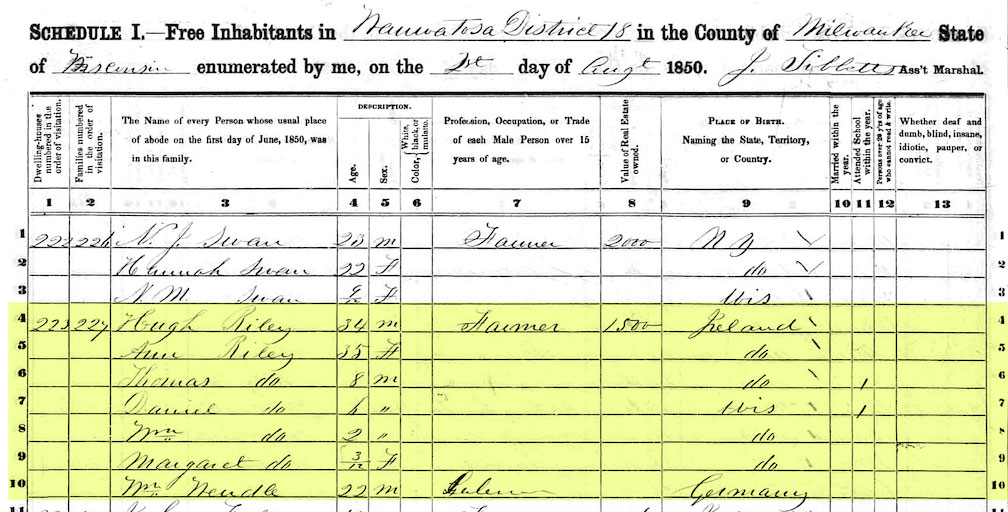
This census tells us the Reilly’s were Irish farmers Hugh and Anne Reilly (spelled “Riley” on that form) and that they had several children by that time. The oldest, Thomas, was 8 in 1850, putting his birth in Ireland around 1842. The next child, Daniel (father of Margaret [Reilly] Mara), was 6 and was born in Wisconsin in July 1844. So that allows us to narrow the Reilly’s immigration date to about 1842-3.
The Riley’s/Reilly’s in Ireland
Prior to emigrating to Wisconsin from Ireland, it seems that our Reilly’s came from County Meath. The earliest of our Reilly’s that we have record of so far are Thomas and Mary Reilly, parents of Hugh. We learn this from the record of Hugh’s eventual remarriage in August 1877 (more later) where he is also listed as being born in County Meath (upper right in map below):
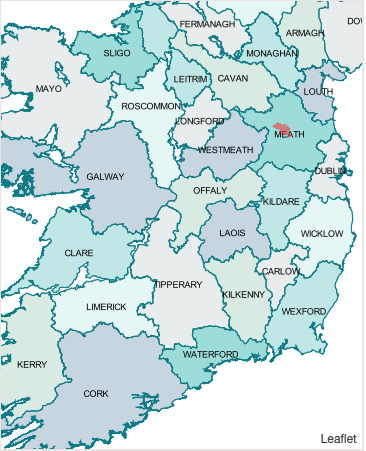
Looking for “Hugh Reilly’s” born in County Meath in the years surrounding 1816 (assuming his age on the 1850 census is correct), we find records such as this baptism of a seemingly different “Hugh Reily” from September 5, 1816. The parish was Dunshaughlin in County Meath. His parents were William Reily and Honora Galligher. Another father named Thomas Reily baptized a son Patrick a few days before:
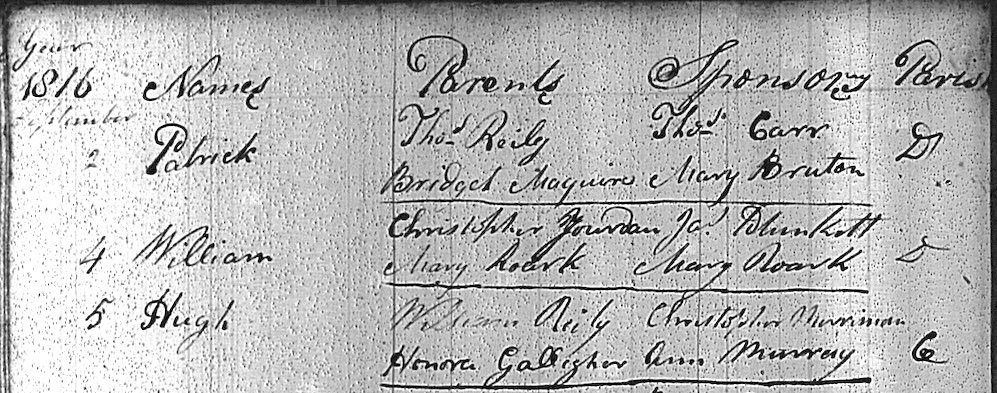
Our known Hugh later had sons he named William and Thomas, so maybe the people referenced in the baptism record were his relatives.
I also found a Hugh Reilly in 1838 owning land in Balnagon Upper, Kilskeer, Upper Kells, County Meath.
A “Hugh Reilly” was a witness to a baptism in County Meath in 1838 (center of image). An Eliza and Catherine Reilly are also listed:
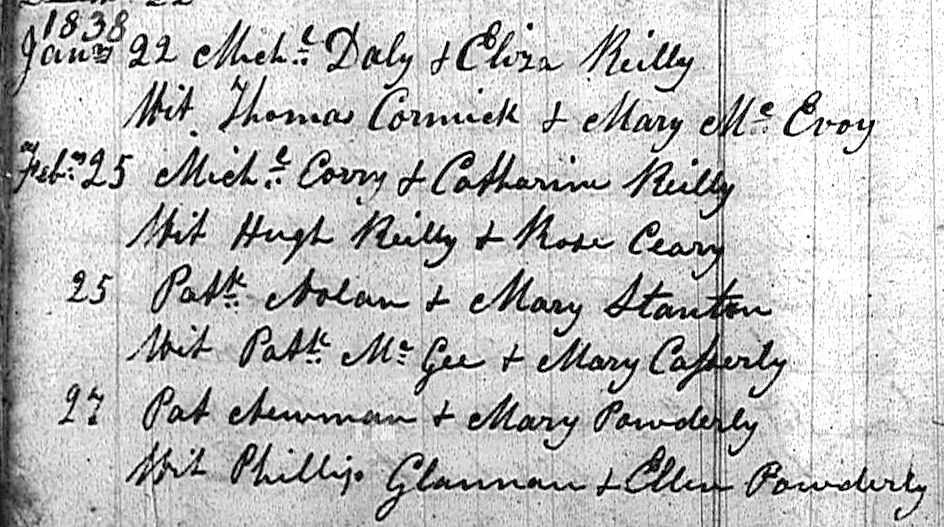
In 1838 a “Hugh Reilly” and “Ann Kane” were married in County Meath – but others of the same and similar names were married in the same time period in various other counties.
Below is what seems to be the original 1842 baptism record for Hugh’s oldest son Thomas while still in County Meath. A transcription of the record gives more detail, including the maiden name of Hugh’s wife Anne (“Kean“, later also spelled “Kane“), and the presence of someone named Mary Reilly (possibly Hugh’s mother?):

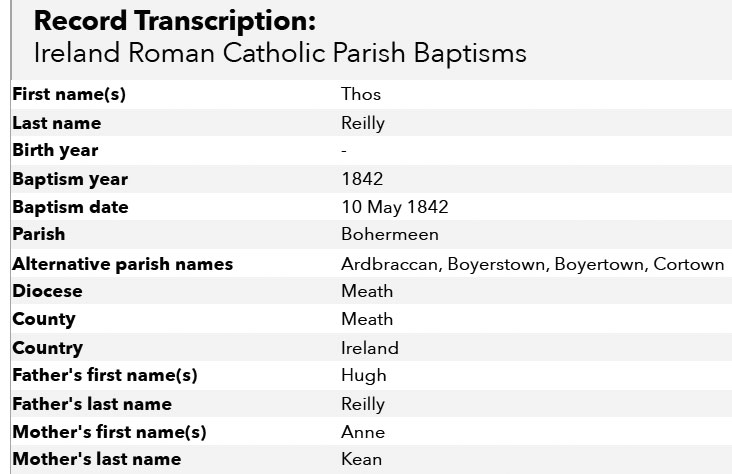
The Riley’s/Reilly’s in Wisconsin
Here in America after the estimated time of their immigration (sometime in 1842), the first record of a Hugh Riley in the Milwaukee area is this notice from October 5, 1842, where he (among a long list of others) has a letter waiting in the post Office. If this is our Hugh, then the family (or at least initially Hugh alone) may have immigrated sometime between May and October 1842:

Trying to pin down an exact immigration date for our Reilly’s is difficult. There are a handful of immigration records for people who may be our particular Reilly’s that I can find from this same time period, but not enough information to say for sure if any of them are “our” Reilly’s.
Various Irish immigrants named “Hugh Riley” and also “Ann Riley” (with variants in the spelling of the last name) arrived in New York between our general target dates of April 1841 and June 1843, but never together on the same date and ship.
Assuming the family members did not immigrate separately, which is of course possible (“chain migration”), the closest we come to having two of our known Reilly family members’ names arriving together on the same ship is this one from April 24, 1843 (the ship George Washington arriving at Castle Garden, Manhattan). Hugh, a farmer from “Great Britain”, is about the right age and baby Thomas is the right age. But an unknown Alice and a Riddy are mentioned, and, as we saw above, a Hugh Riley was already in the Milwaukee area the year before:

In the late 1830s, people were still building log cabins as they first settled near Milwaukee so the Reilly’s arriving only several years later might be considered pioneers in the area. Our Reilly’s were definitely already settled in WI for Daniel’s birth in 1844, and we know they were specifically in Wauwatosa in 1850 via the census shown above, and Hugh and his son William were still there a few decades later.
According to Wikipedia, “The Town of Wauwatosa was created by act of the Wisconsin Territorial Legislature in 1840, and the town government was organized in 1842”, perhaps just as the Reilly’s were arriving in the area.
There are Milwaukee-area land purchase records for both a “Hugh Riley” of Racine County (1844) and “Ann Riley” of Waukesha County (1852), but they are both a little distance from Wauwatosa and may or may not be our Reilly’s (again, that’s the problem with these Irish surnames…). A Hugh Riley of Brighton, Kenosha County (with a wife named Catherine) died on December 25, 1876, so he is not our Hugh.
But we’ll look at the records anyway, just in case. Here are extracts from the two documents for “Hugh’s” properties:
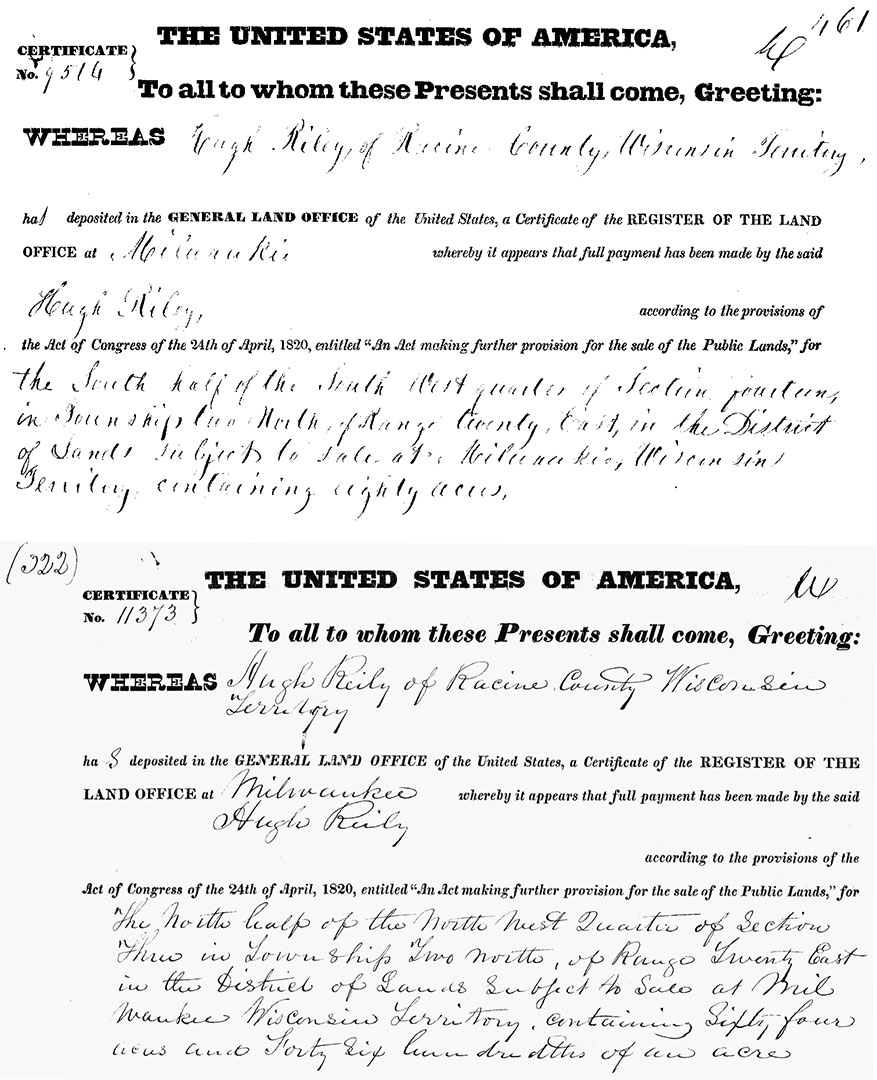
Here is a map of “Hugh’s” property locations (Wauwatosa would be about where the “A” in Milwaukee [County] is, just above Racine, on the right of this map). An unknown Catherine Riley is associated with one property:
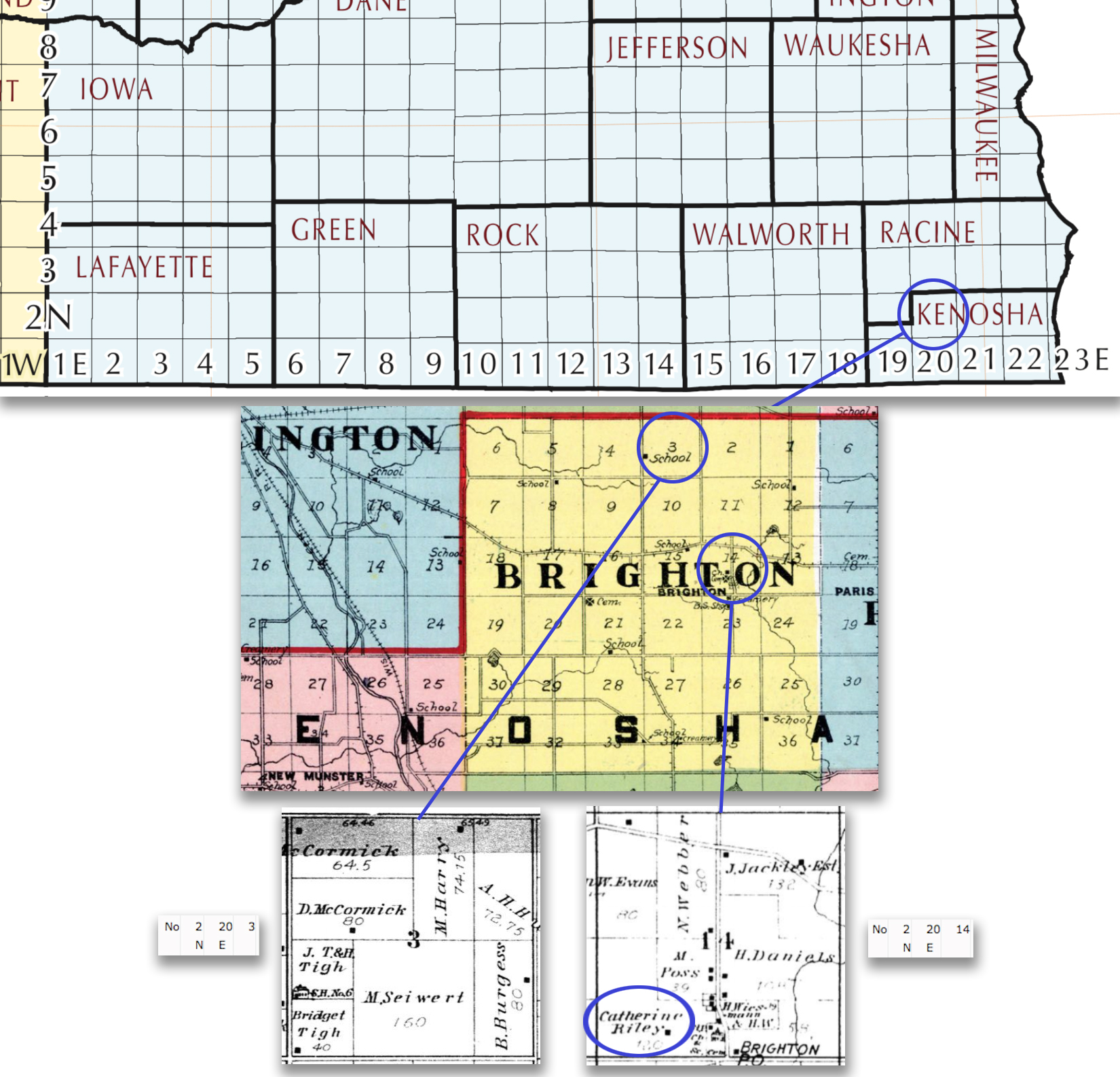
The 1875 Wisconsin census has a “Hugh Riley” living in Kenosha County (which seems to agree with the map above) with two white males and two white females. Our Hugh was in Wauwatosa on the farm through at least 1876 (see later in this post), so this is probably not him, as this other Hugh bought this property in 1844 as we saw above:

Here is a portion of “Ann Riley’s” property record:
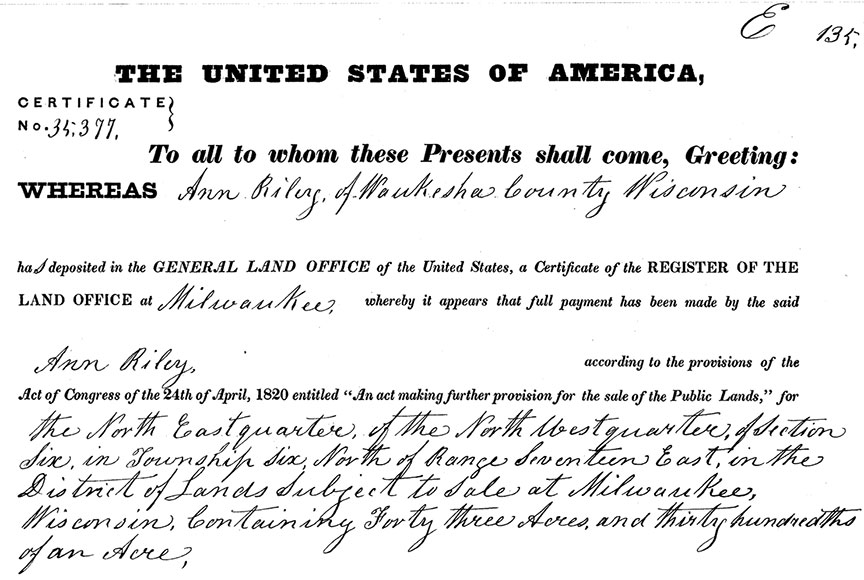
And here is the location of the property based on the description, in the county just west of Milwaukee County:
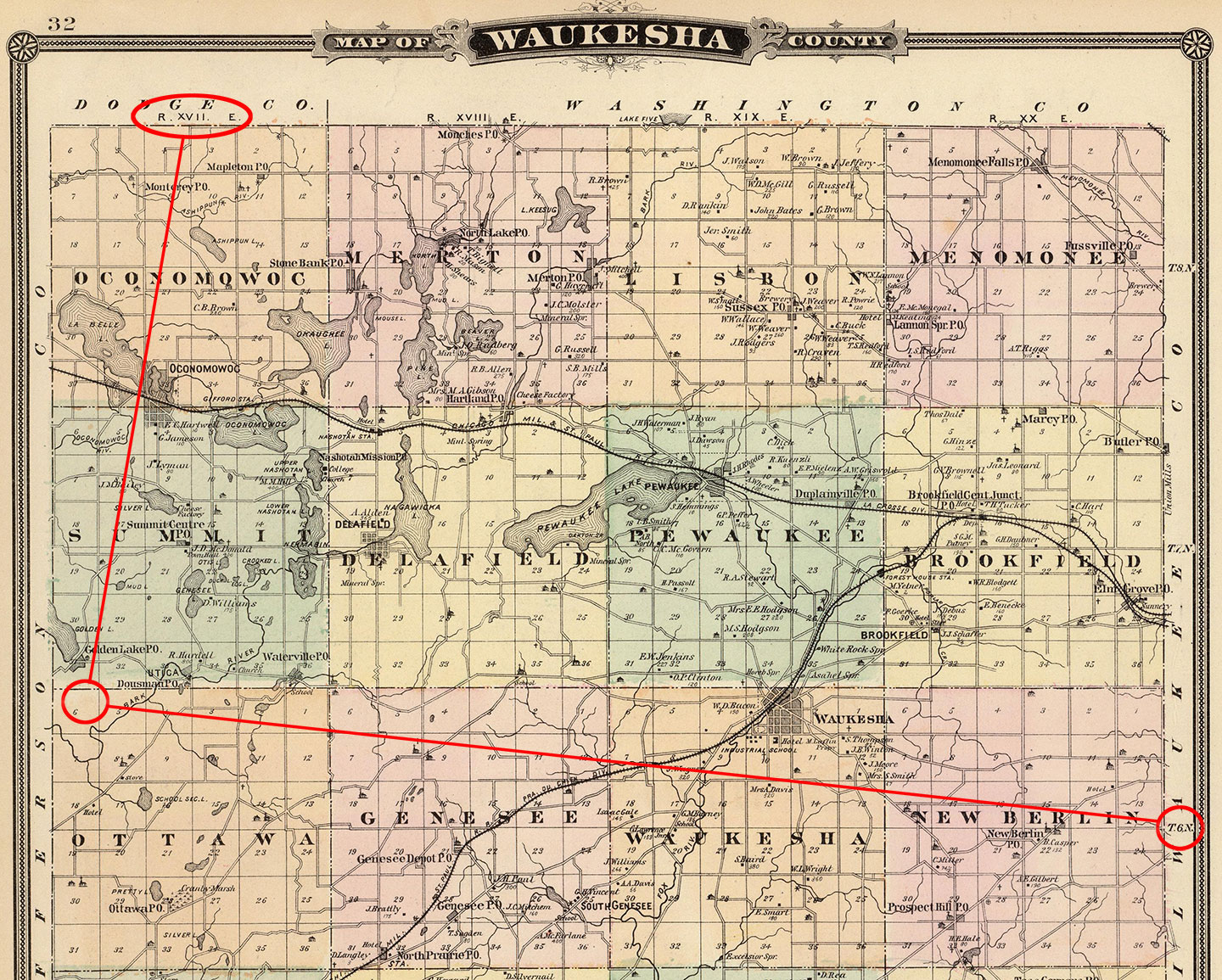
At this point I can’t prove a connection between these other Reilly properties and our known Reilly’s, but the similarity of names and near proximity to Wauwatosa is worth mentioning.
The Riley’s/Reilly’s of Wauwatosa, WI
First, a modern map of the City of Wauwatosa just to the west of Milwaukee. Our main interest going forward will be in the area of the map at the intersection of D-4:
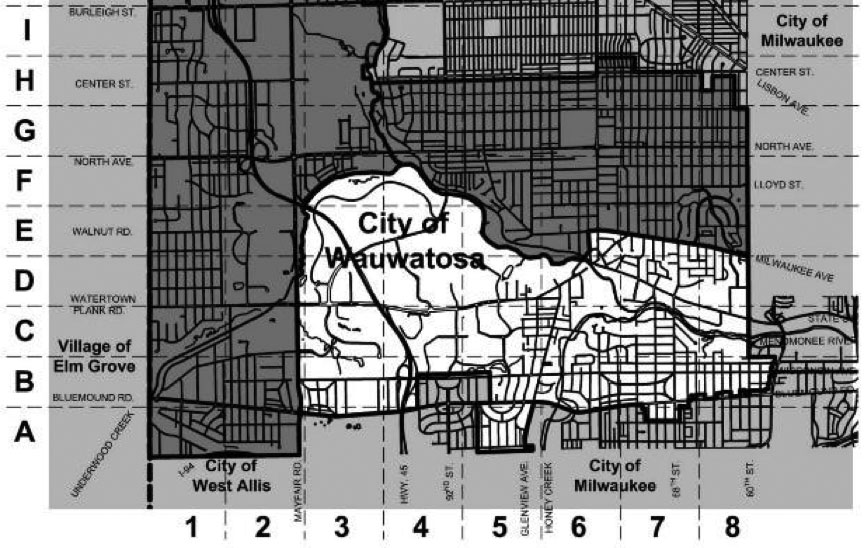
Next, a bit of Wauwatosa history from this document, with our focus on the years just before and after the Reilly’s arrival about 1842:
“The land that would become Wauwatosa was occupied by the Menomonee tribe north and east of the Milwaukee River and the Potawatomi tribe south and west of the river in the early 19th century. The United States Government purchased the land from the Potawatomi tribe in 1833, and proceeded to relocate Native Americans, surveyed the land into parcels for sale, and organized and opened the area for settlement. In 1835, the area was organized as a part of the Town of Milwaukee in the newly formed Milwaukee County.
“Wauwatosa’s first permanent white settler, Charles Hart arrived in Milwaukee County in 1835 and purchased a large tract of land five miles to the west on which to develop a settlement. He built a log home, sawmill, and grist mill on the west side of the Menomonee River that same year. Seventeen other settlers joined him, and the settlement became known as Hart’s Mills, the second settlement in Milwaukee County after that which would become the present-day City of Milwaukee. A United States military road from Milwaukee to Madison was constructed through the settlement near the mills in 1836…
“A cemetery was established north of the settlement in 1839, which was eventually moved to a larger, permanent location along present-day Wauwatosa Avenue north of North Avenue. The settlement, which served primarily as the commercial center for the surrounding farming community and a transportation hub clustered around the mills, added a blacksmith shop by 1840. The first public school in the community was established near its center in 1841.
“In 1842, the western half of the Town of Milwaukee including the settlement of Hart’s Mills was established as the Town of Wauwatosa…
“Beginning in 1848, the portion of the military road between Milwaukee and Watertown was converted into a toll plank road and came to be known as the Milwaukee-Watertown Plank Road west of the village center. The construction of the Milwaukee & Mississippi Railroad reached Wauwatosa from Milwaukee in 1850, and the settlement’s commercial area expanded.”
Back to the known Reilly family facts: Here is an 1837 survey of the Wauwatosa area, where we know for certain our Reilly’s lived for a few decades. At center left is Section 20, which includes a distinctive arch in the Menominee River. The Reilly’s would later settle and raise their family in a house built on the lower right half of Section 20:
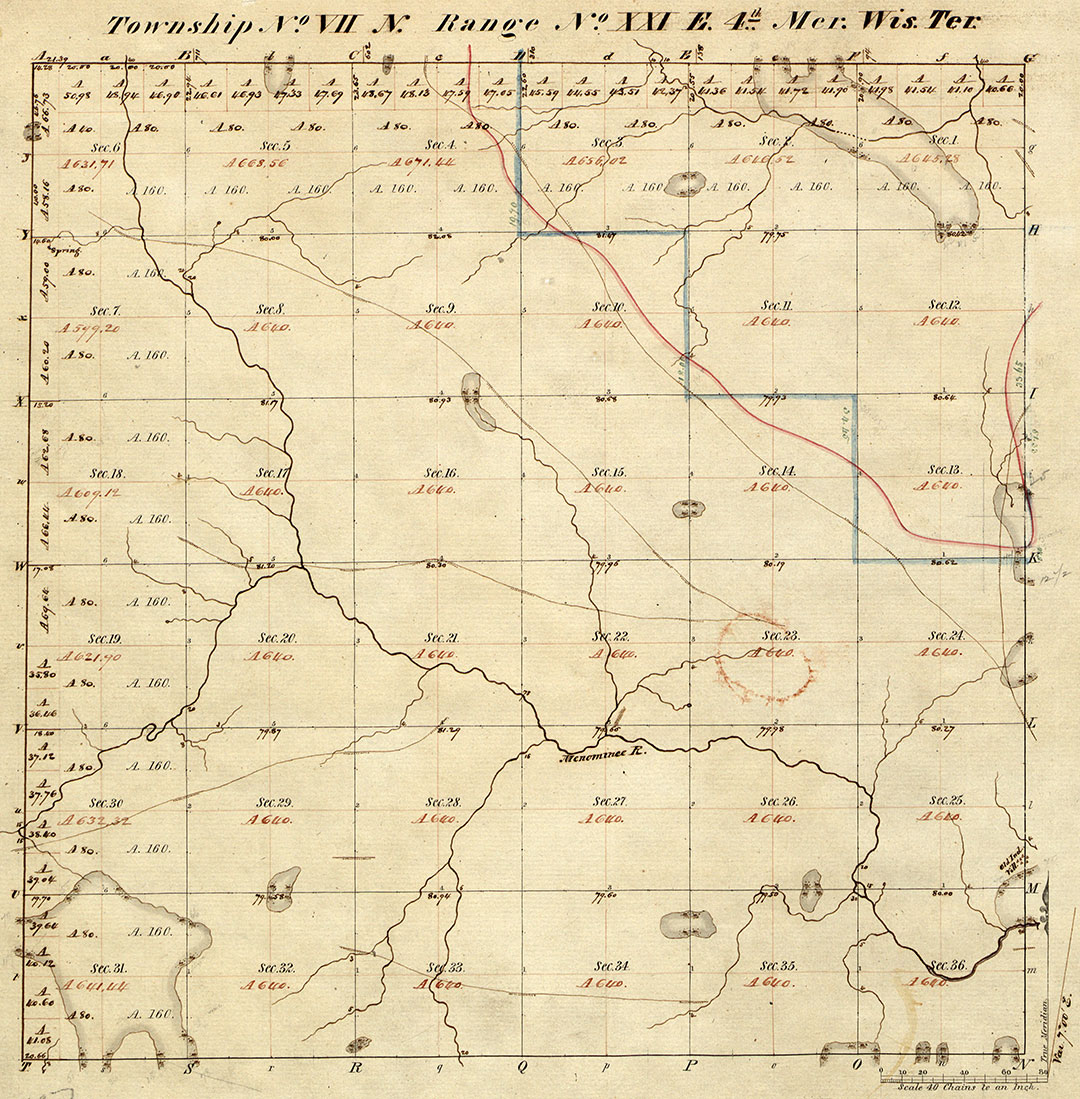
A later 1800’s map shows where Wauwatosa is located in relation to Milwaukee, as a western suburb only several miles away. Section 20 is easily found, again, center left:
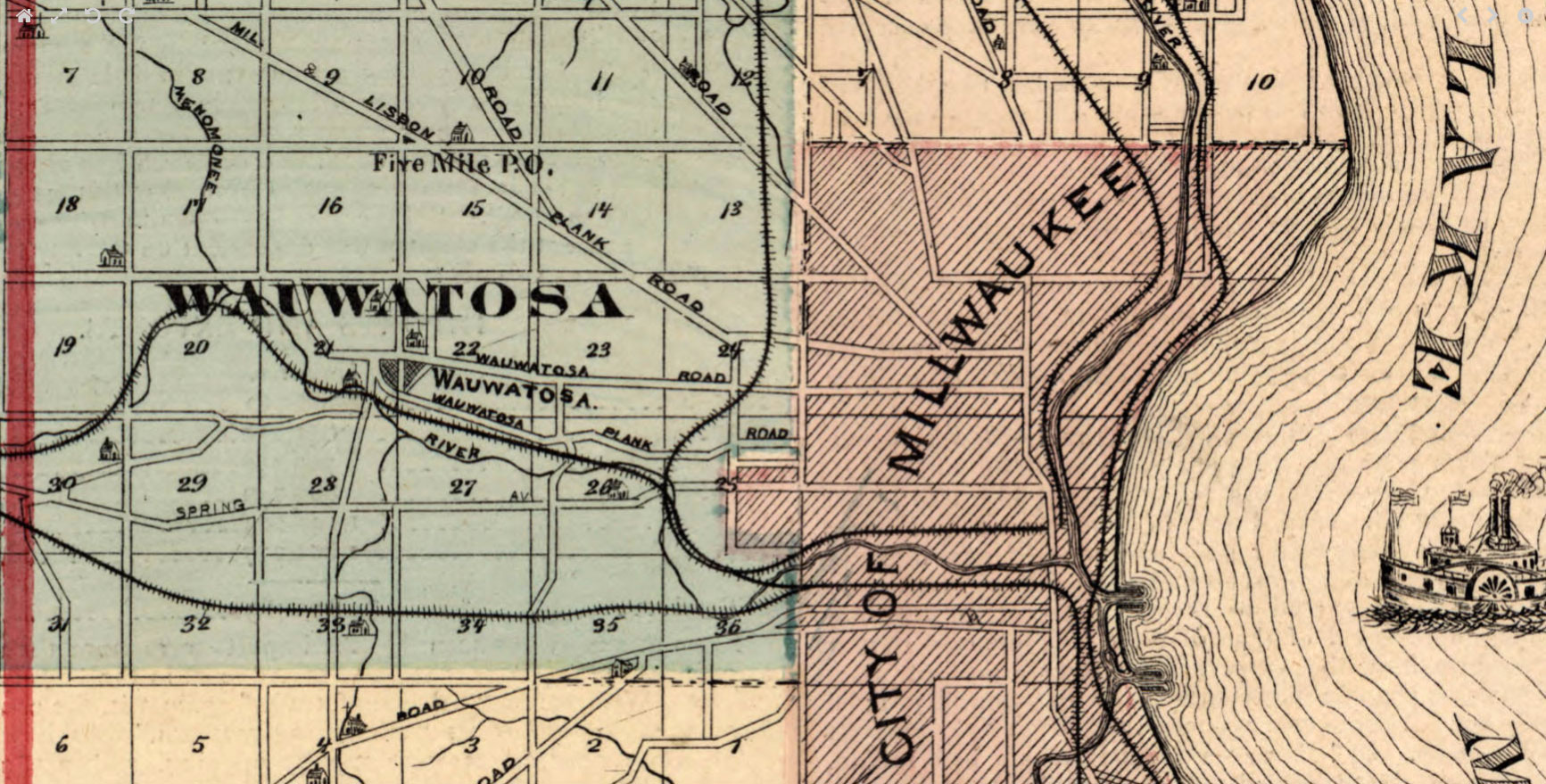
An 1892 illustration shows Wauwatosa in the foreground, looking east toward Milwaukee in the distance. The Reilly farm would have once been located slightly out of the frame at lower left:
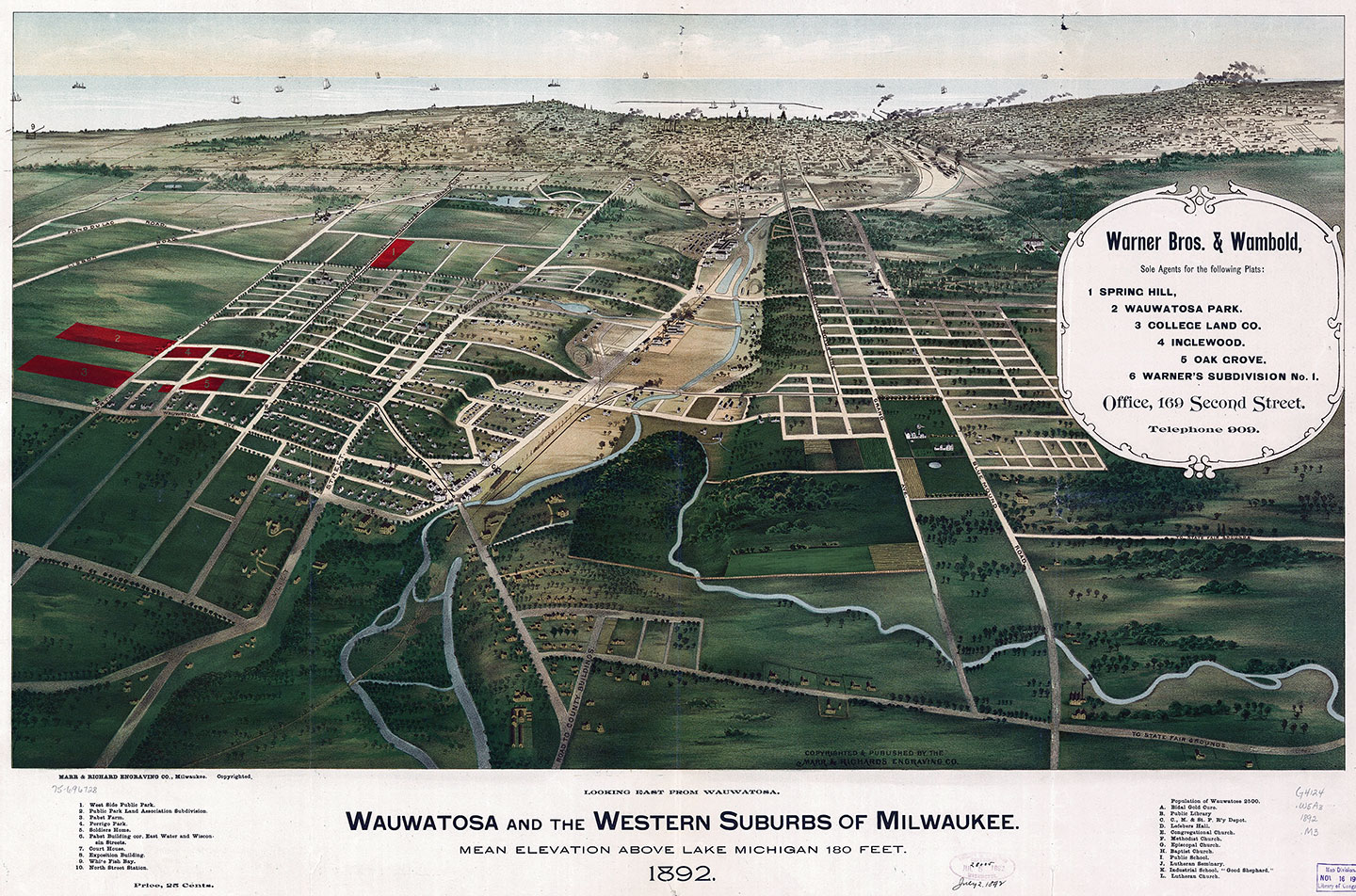
Getting back to our chronology, in 1855 a Hugh Riley shows up on the Wauwatosa census, surrounded by names of neighbors that appear on later farm maps of our known Hugh’s property:
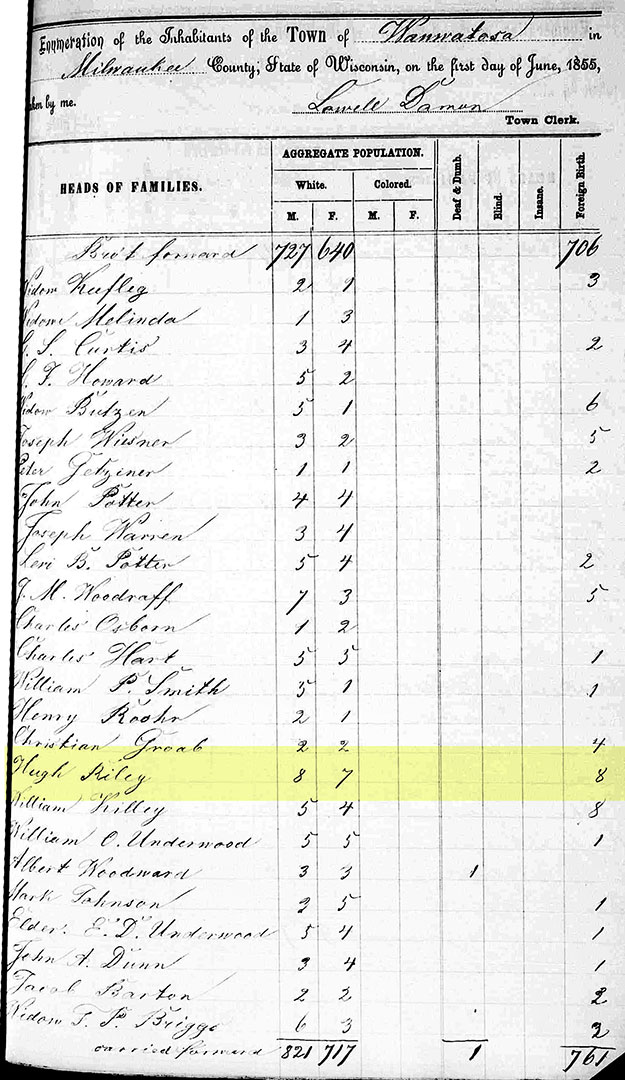
In 1858, a detailed map was made of the Milwaukee area with farms labeled as to owner or occupant. Here is an overview section of the map with Wauwatosa at left. The Milwaukee and Watertown Plank Road, which is shown running immediately south of and alongside the Reilly’s farm, is highlighted in blue:
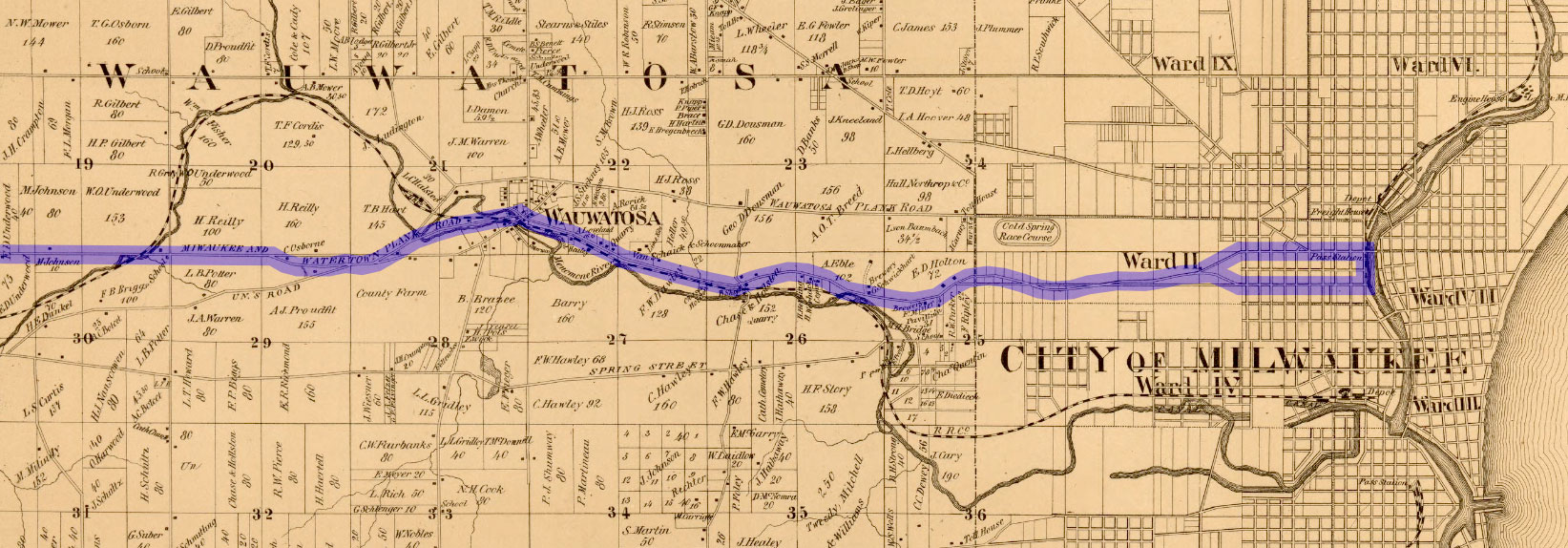
The Plank Road was built shortly before the Reilly’s settled in this area, and its construction went ahead despite the disadvantages of such a wooden road (as described in this January 1845 article in the Milwaukee Sentinel entitled, “Union of the Mississippi with Lake Michigan by a Railroad through Wisconsin”):

“Started in 1848 and completed in 1853, extended 58 miles west from Milwaukee on a course roughly paralleling State Street past the Frederick Miller Plank Road Brewery through Wauwatosa, Pewaukee, and Oconomowoc to Watertown. The $100,000 road of white-oak planks provided a route for farm products, wood, lime, and passenger vehicles. It cut round-trip travel time to three days, all at a toll of about one cent a mile.” (See here for more searchable WI historical info such as this.)
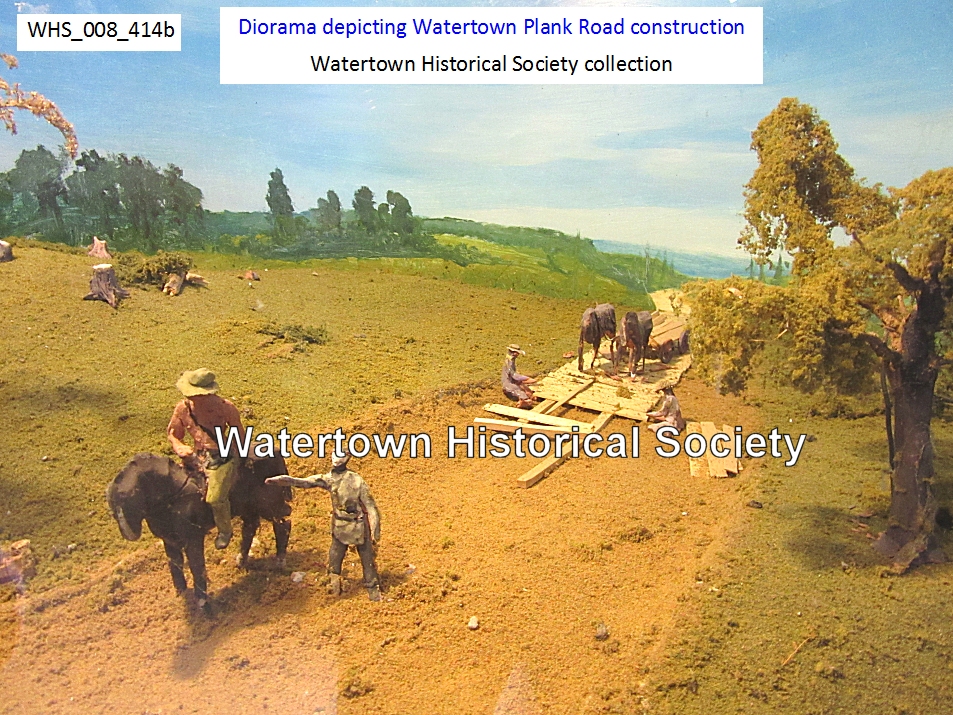
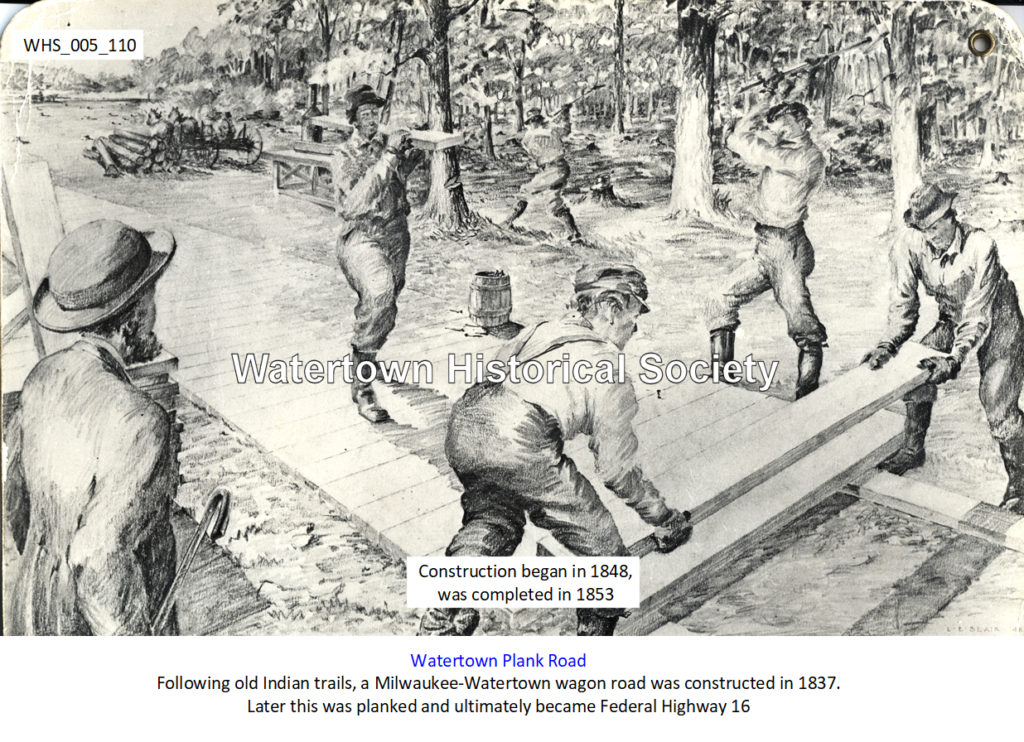
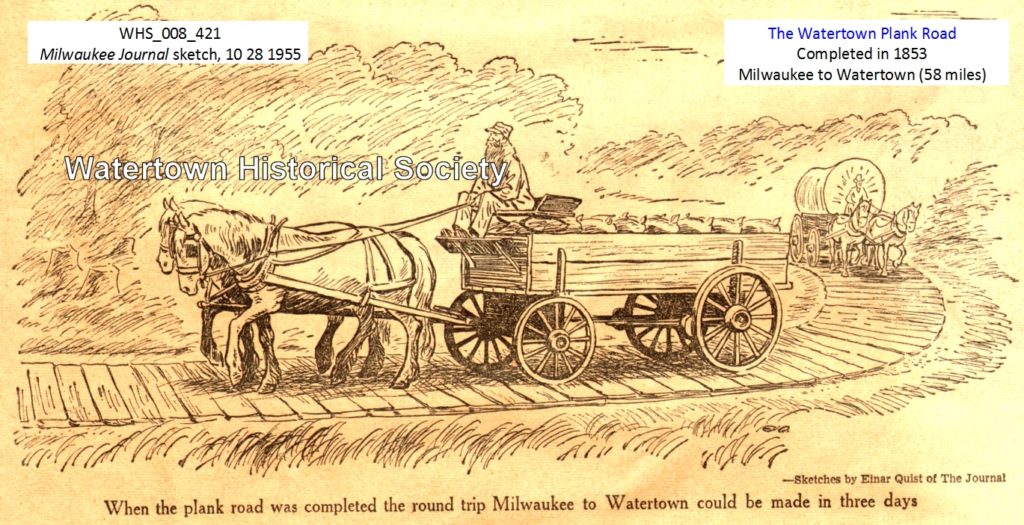
It appears the Reilly’s lived right along the stage coach route from Milwaukee to Watertown, which was advertised in April 1846:
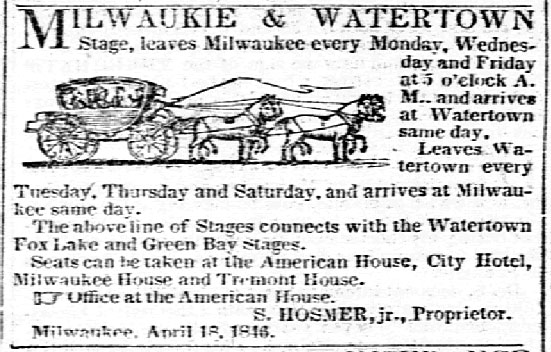
Here is a detailed view from the same 1858 map as above, showing the Reilly farm holdings (a total of 260 acres), with the Plank Road along the bottom:
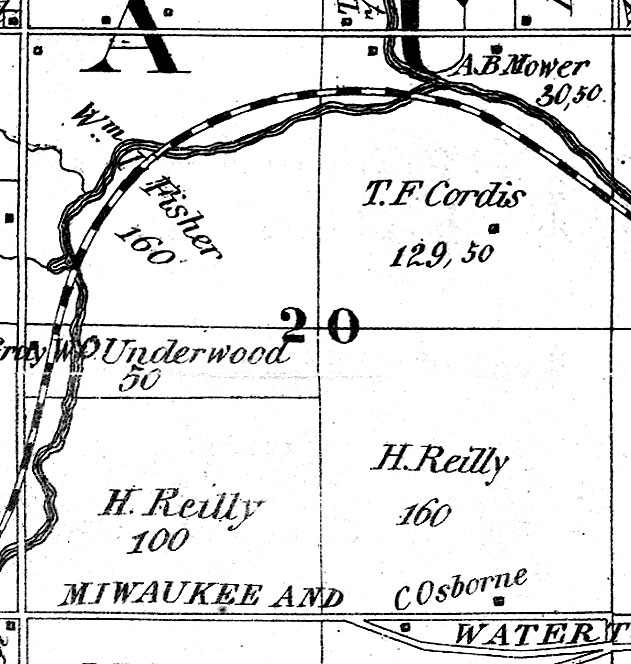
This map pinpoints the location of the Reilly farmhouse, a simple square at lower right, below the “n” in Osborne and above the “A” in Watertown. This proximity to the Plank Road, which is still there (although now a much-widened highway), makes it possible to find the current location of the farm site (see more about the story of the Reilly farm property at the end of this post).
In January 1860, a Hugh Riley is named in the Daily Milwaukee News being paid for some claim:
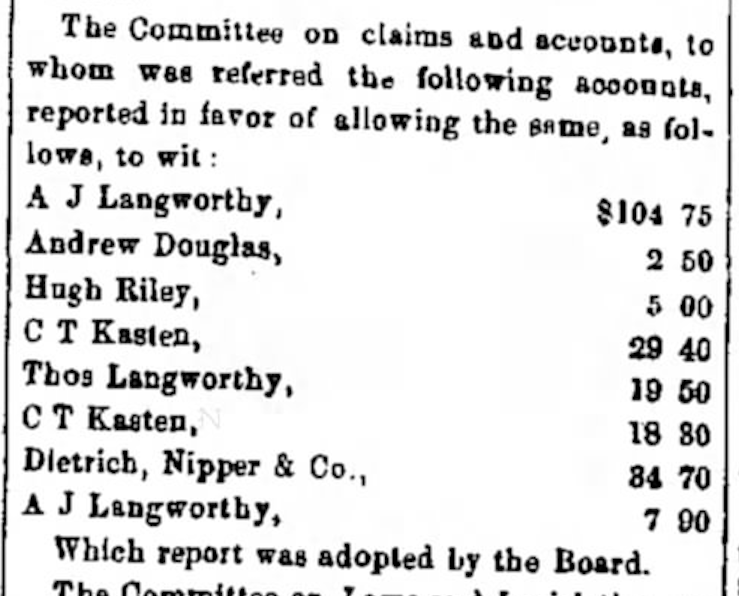
In April 1860, we see the first of a few situations in the years ahead where Hugh’s property is being seized and offered at public auction. I only have an incomplete preview reference to this particular event:
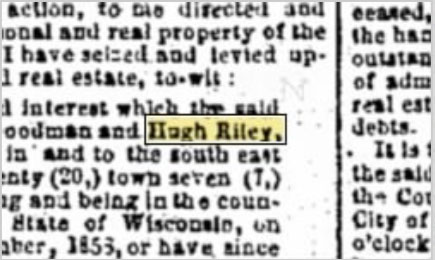
In July 1860, we see our known Reilly (“Riley”) family on the census again, with neighbors Osborne and Underwood (from the above map) listed alongside. I’m not sure if domestic Rose Riley, age 35, is a relative:
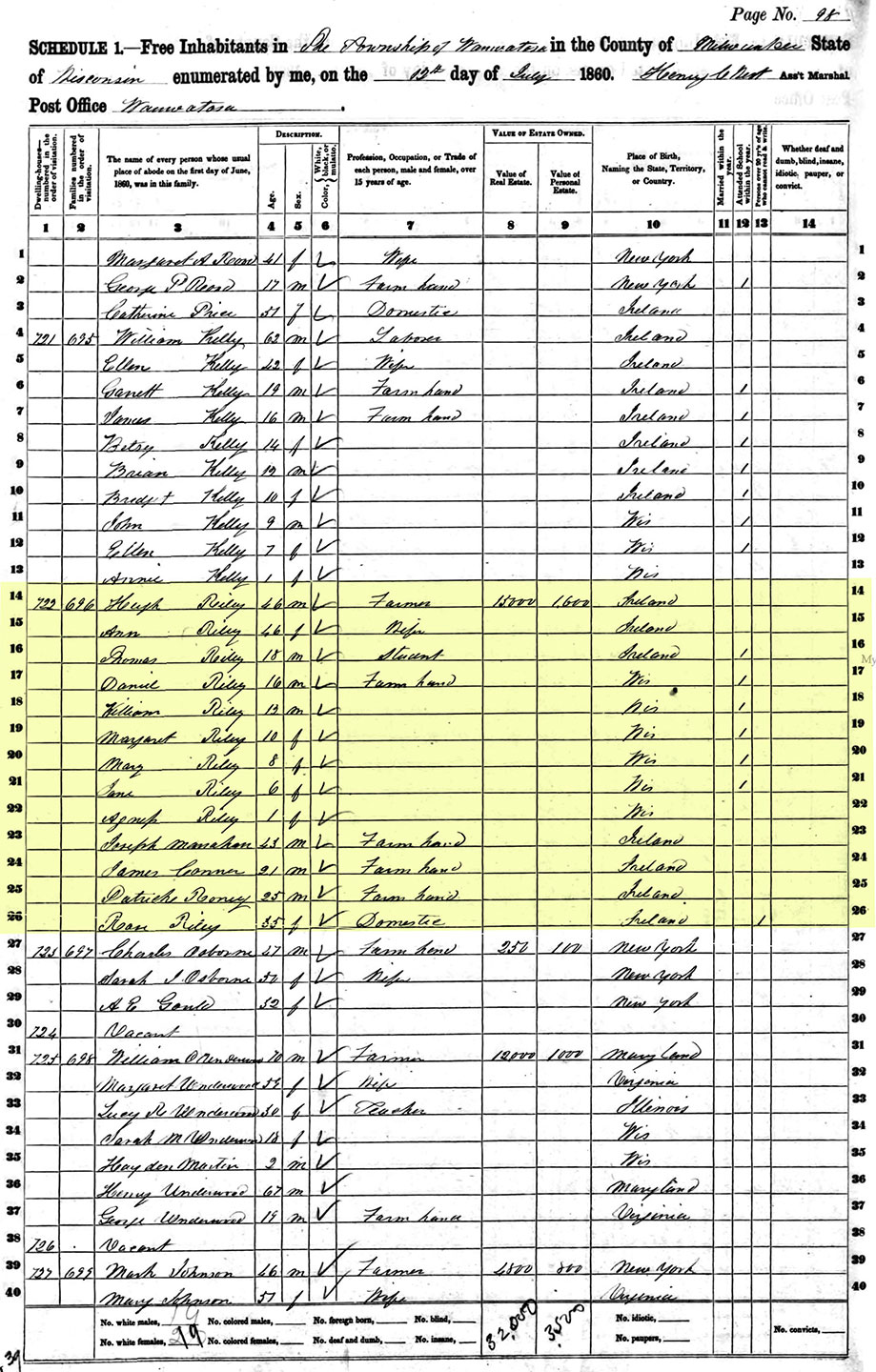
The Civil War comes to Wauwatosa
By 1861 the Civil War was on, and we must interrupt our story just as the Reilly’s quiet lives on the farm were interrupted. It seems that three of the Reilly’s were involved in the war (father Hugh and oldest sons Thomas and Daniel).
We’ll start with Hugh since he was obviously the oldest at the time.
There seem to be three Hughs with the surname of Reilly in the WI Civil War records (with the surname’s spelling all over the place). The one who served as a veterinarian was from Beloit WI, so he is probably not our Hugh.
This record seems most likely to refer to our Hugh, as his regiment number (49) coincidentally comes right before that of his son Daniel (50, 51), as we will see below:
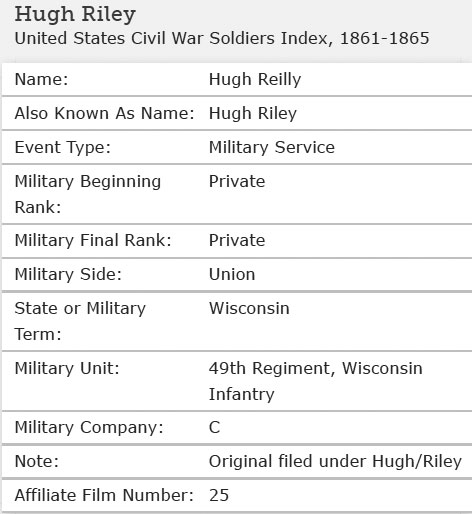
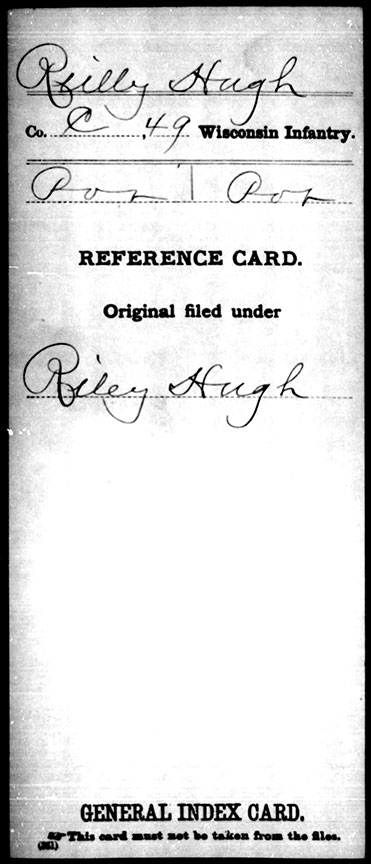
According to “Roster of Wisconsin Volunteers: War of the Rebellion”, oldest son Thomas H. Reilly enlisted on November 2, 1861 as a corporal. His movement through the ranks of the 17th WI Regiment was as follows:
Promoted to Full Sergeant. Promoted to Full 2nd Lieutenant on 19 Nov 1862. Promoted to Full 1st Lieutenant on 26 Aug 1863. Promoted to Full Captain on 28 Oct 1864.


On April 22, 1864, the Seventeenth departed Wisconsin for the South. Thomas Reilly is named at the bottom under Company I:

“On the 5th of May, 1864, the Seventeenth was assigned to the Third Brigade, Third Division of the Seventeenth Army Corps Army of the Tennessee, of Sherman’s Army, and as a part of such organization participated in the Atlanta Campaign, May 1 to September 8, 1864. It also participated in the battles of Kenesaw Mountain, Chattahoochie River, Jonesborough and Lovejoy Station.”
In July 1864 during the Atlanta campaign, Thomas received an injury that thankfully was not more serious than it could very well have been:
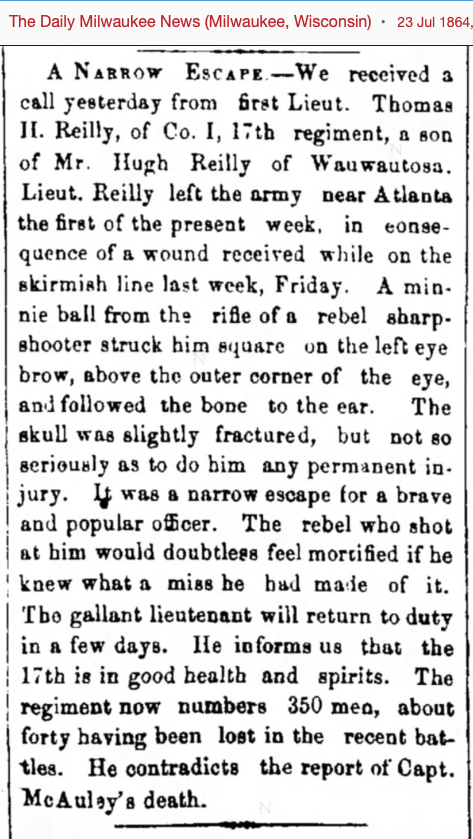
(Thomas survived this wound as well as the war and eventually settled in Pass Christian, MS, sparking rumors in our family that he fought for the South, but he did not – he fought in the South and settled there sometime after returning to Wauwatosa for a time after the war.)
The roster of the Seventeenth Regiment with Thomas made Captain as of November 8, 1864:
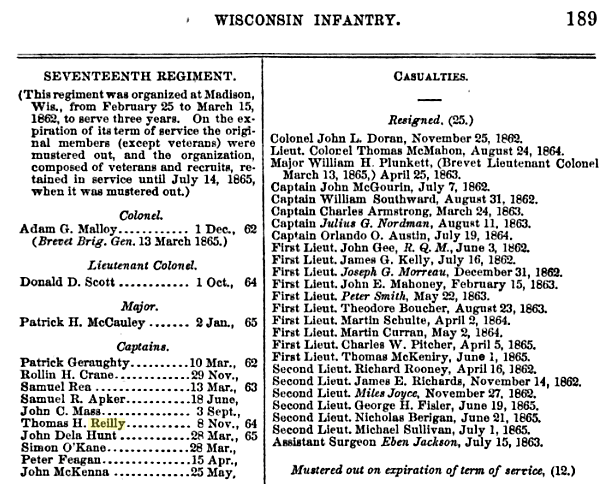
On April 10 1865, Hugh’s next youngest son (after Thomas), Daniel E. Reilly, age 21, volunteered for the beginning of a four-month service in the Civil War, as First Lieutenant in WI Company E, 51st Regiment:
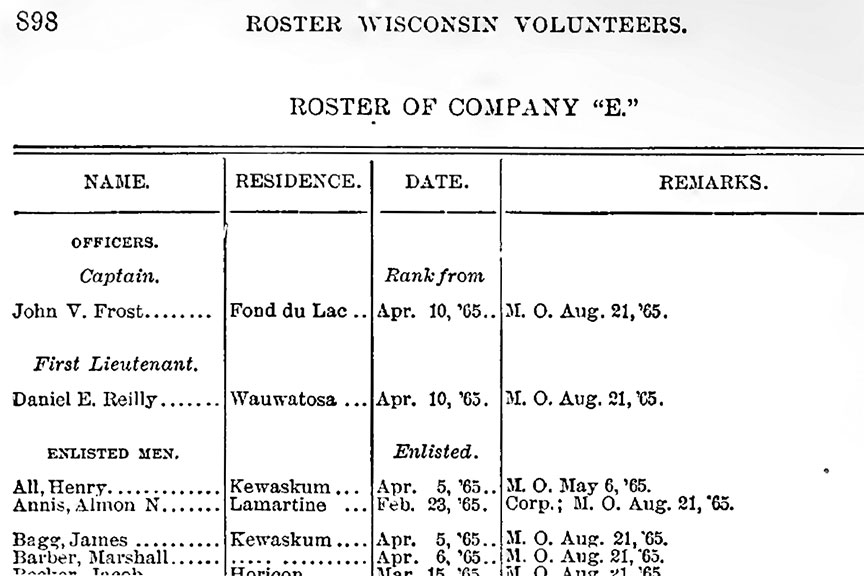
Here is another mention of Daniel’s service (toward the bottom of this list):
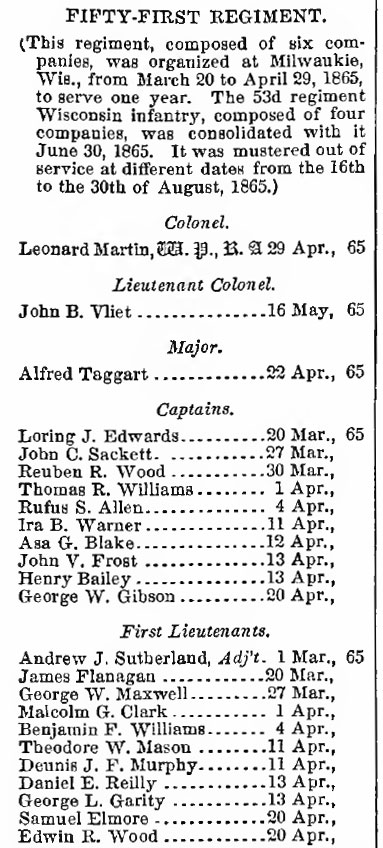
Days later, on April 26, 1865, Daniel’s regiment headed out for St. Louis, to guard the building of the railroad at Pleasant Hill, MO that spring and summer:
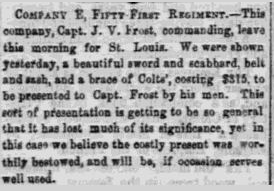
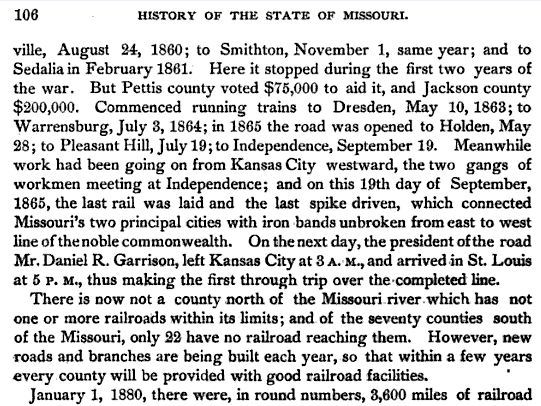
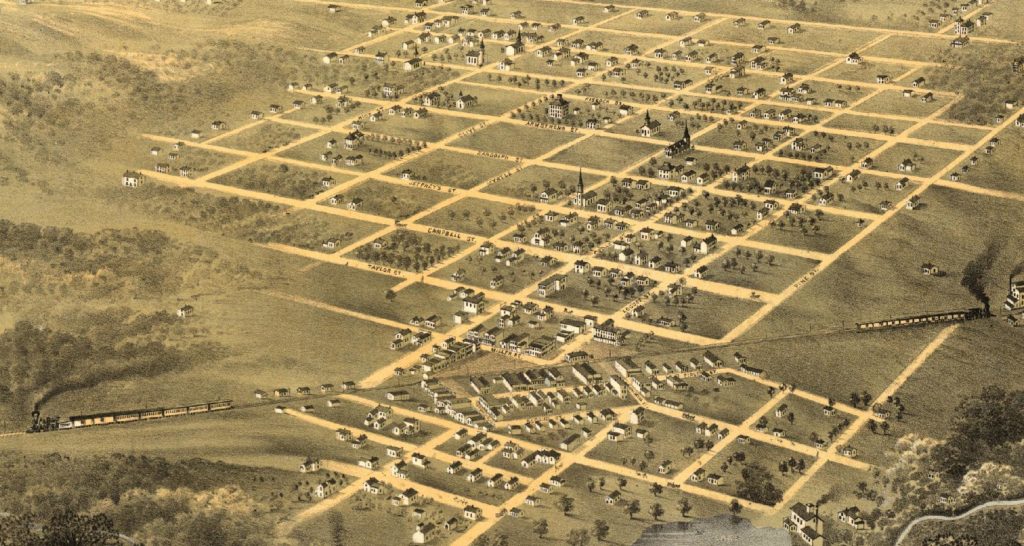
Below is supposedly a photo of Daniel during the time of his service. It was hanging in his daughter Margaret Mara’s home in 1954 (lending it a bit of credibility) and was colorized at some point by a family member:
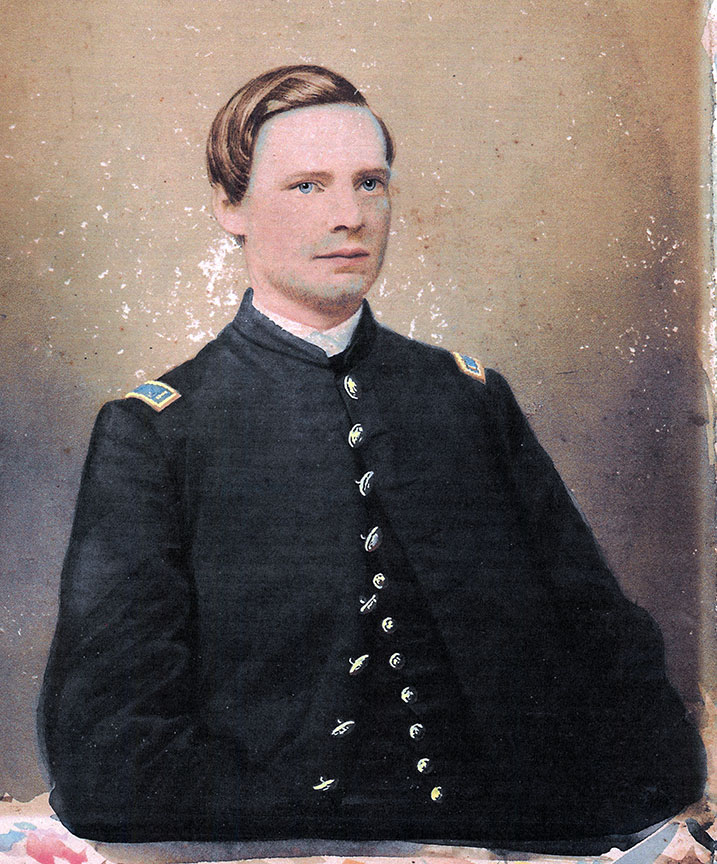

The insignia in the photo matches that of First Lieutenant:
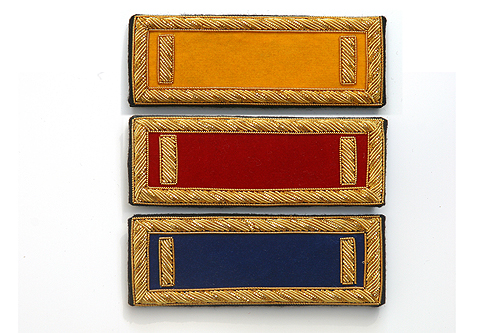
One of Daniel’s Civil War swords has remained in the family all these years:

During the war, in April and August 1864, Hugh Reilly continued to have some sort of mortgage trouble with farm owner William O. Underwood (one of the first settlers of Wauwatosa), who took Hugh to court again before Underwood died on August 26. The issue must have been resolved somehow because the Reilly’s remained on the land, or at least part of it. Announcements about the court cases ran in the paper in April, August and September. The two clips below were from the same day, April 27:


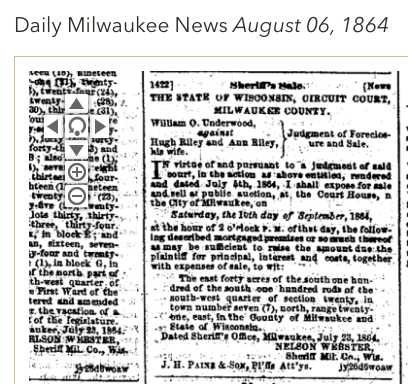
In June 1865 Hugh seems to have been given credit for a payment to Underwood:

(A quick aside about the Underwoods: In 1912, a small article about Fred D. Underwood, president of the Erie Railway, described how he returned to his parents’ Wauwatosa home every year):
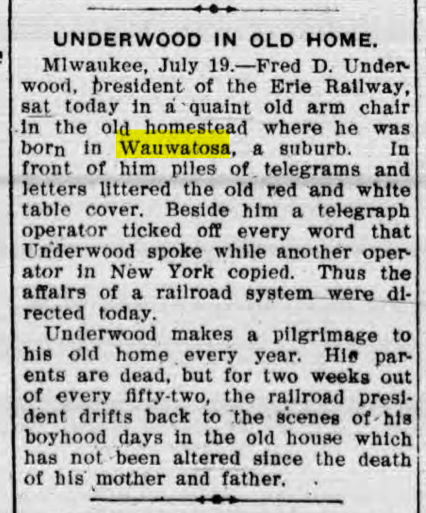
Om August 4, 1865, Hugh appeared on a published Income Tax List to the tune of $400.
In this 1865 report, brothers Thomas and Daniel are listed together in the 51st Infantry. They had a younger brother William M. Reilly but the one listed here is from Berlin WI:

On August 24, 1865, Daniel E. Reilly musters out of the 51st:
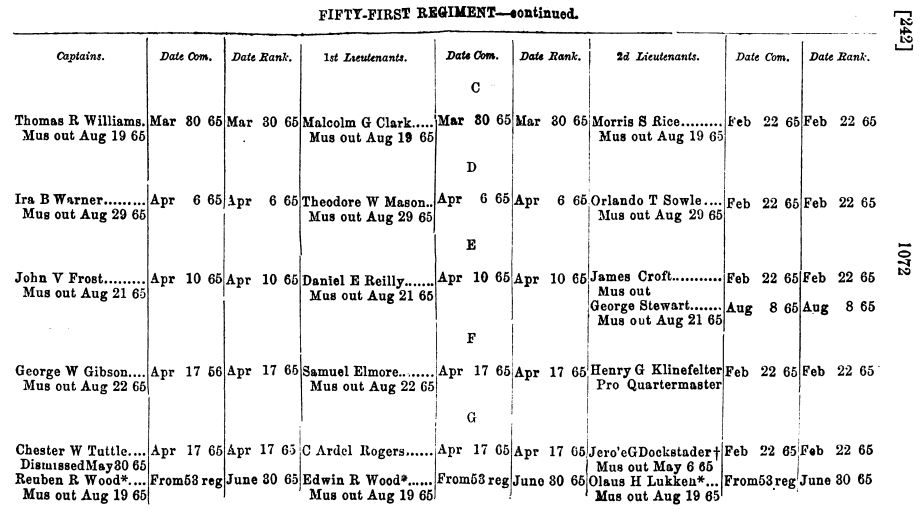
On March 2, 1869, Hugh Riley was part of a grand jury in Milwaukee:
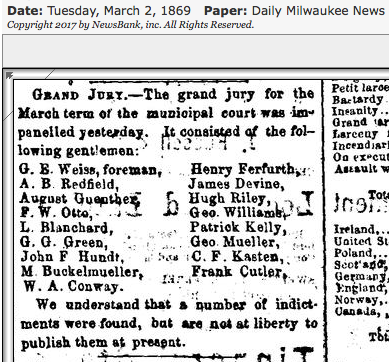
In August 1869, Hugh’s wife Ann Reilly died of consumption at age 55:
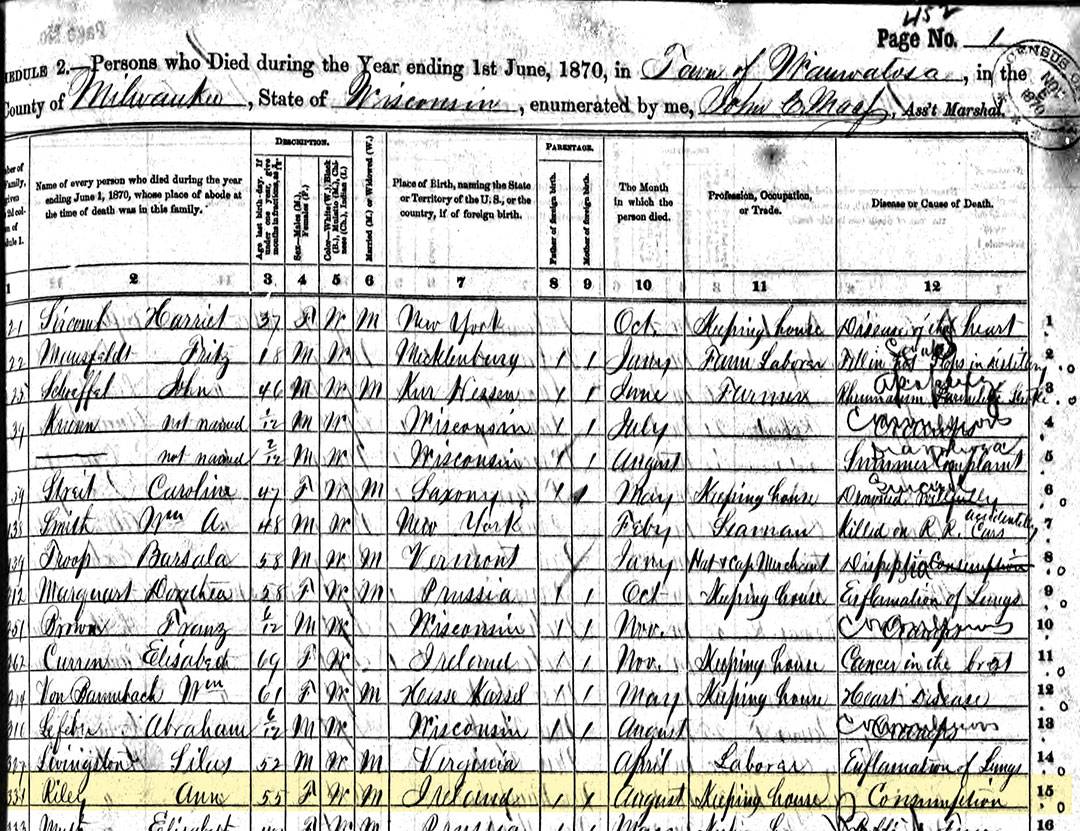
This photo from the Mara family collection was labelled as possibly being “Great Grandma Reilly”. She does bear a striking resemblance to her grandson Rev. Frank Reilly, below:
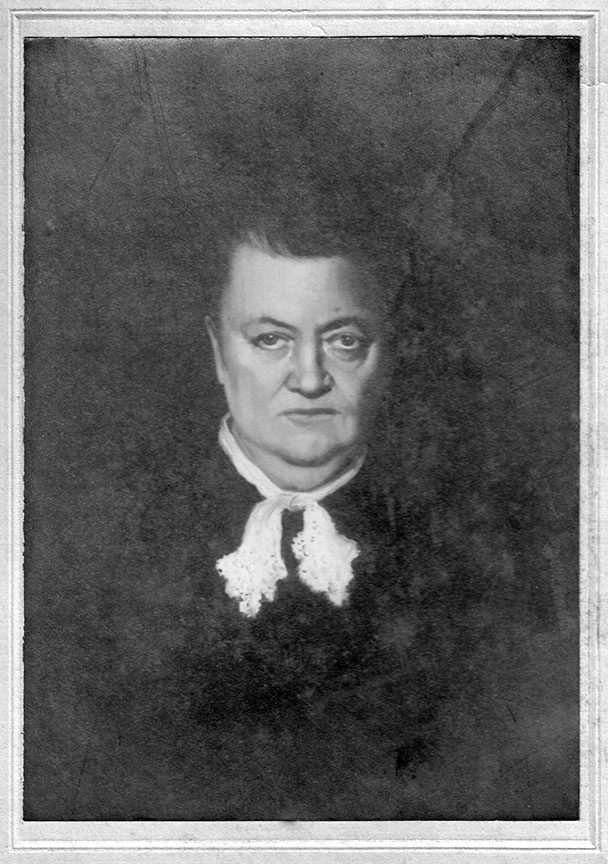

On November 18, 1869, Hugh was once again a juror:
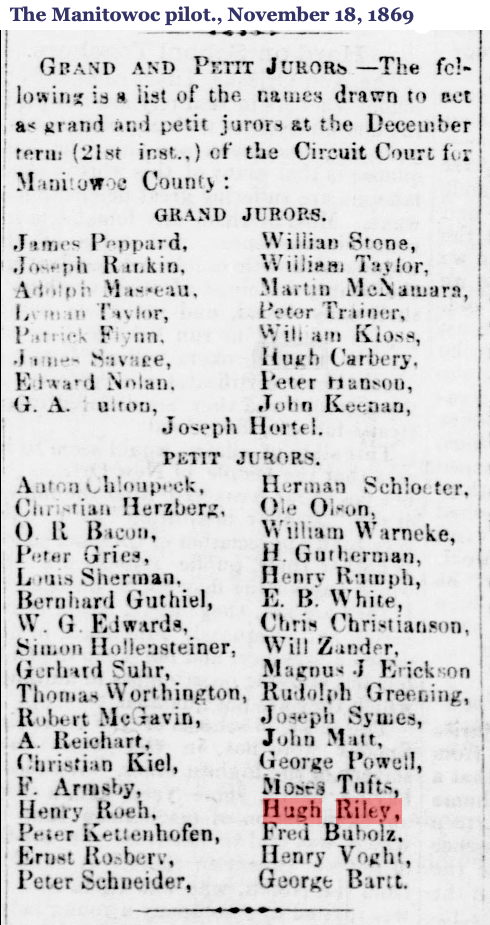
In 1869, a revised map of Wauwatosa shows that the Reilly farm (the surname butchered to “Rily”) had shrunk to just 200 acres, with the Reilly house still marked (next to the “D” in Road). Note the addition of the Kelly farm next to “Osborn”, whose owners are listed in the 1860 census above:
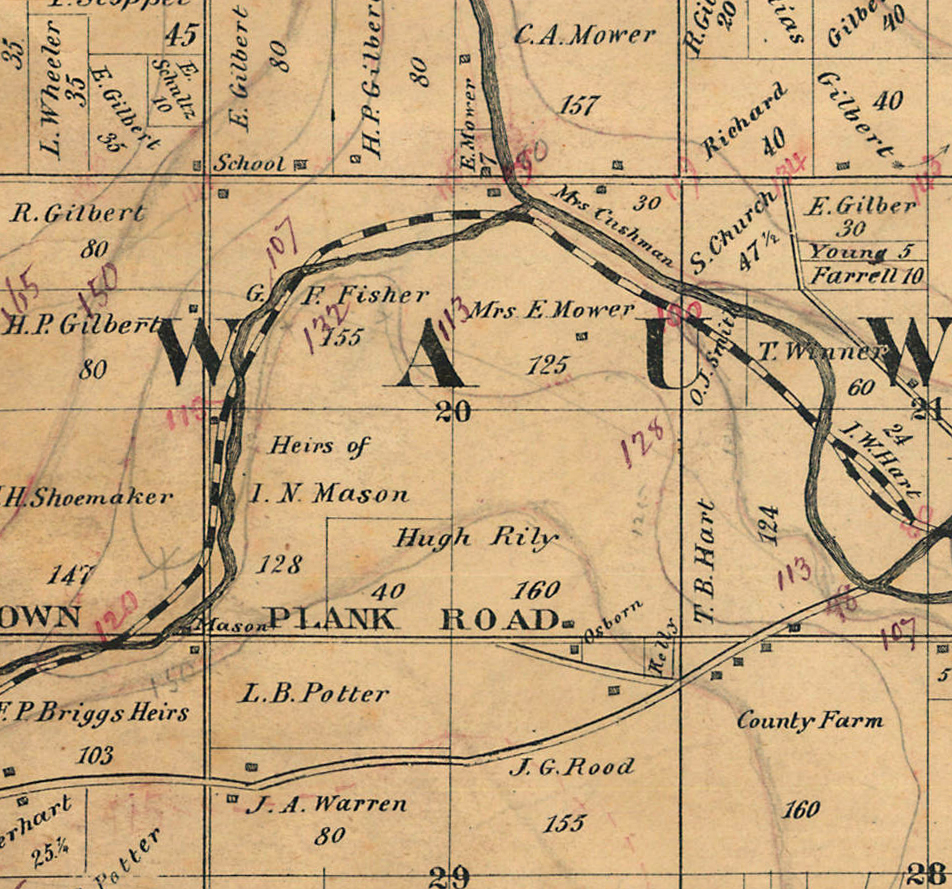
The 1870 census below shows the Reilly boys Thomas and Daniel back from the war and still working on the farm (though an undated 1870 census in Mississippi, not shown here, lists a “Thomas Reiley”, farmer, age 30, born in Ireland, living in the town of Woodville):
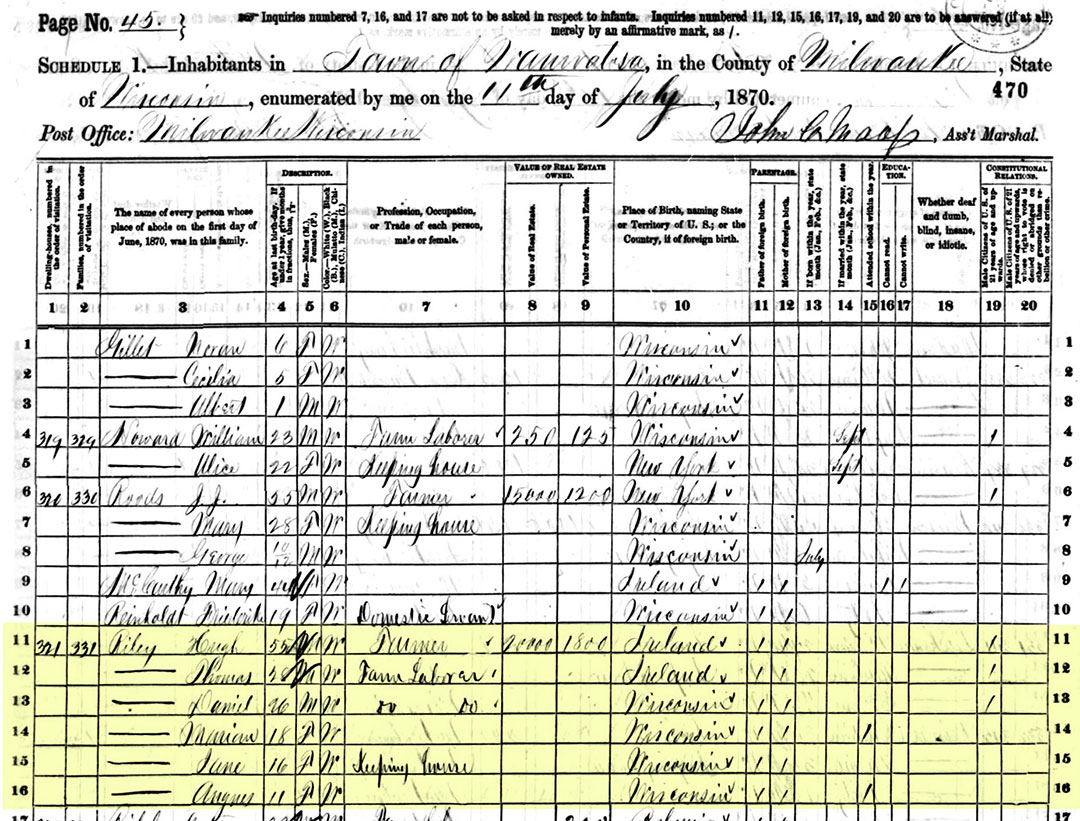
Let’s take this opportunity to discuss some of the other Reilly children. William, Daniel Reilly’s younger brother, was married to Susan J. McDonald in August 1881. Daniel and William are the only Reilly children with known descendants:

Margaret Reilly, listed on the 1860 census, is no longer listed here (she would have been 20). Whether she died or married is unknown at this time.
Mary (or Miriam) Reilly was next, and presents us with a bit of a mystery. A person with her same name, birthplace and parents died in 1929. This record, shown below, contradicts information given for a Mary Florentine Riley, said to be the sister of Jennie Riley, who was a known daughter of Hugh Riley of Wauwatosa, named in association with the events of 1884 described below (this is a mystery to be solved at another time):

On the July 11, 1870 census (above), both Mary and younger sister Agnes are noted as having attended school that year. A Mary and Agnes Reilly of the same general ages appear a couple of weeks later on the July 29 census as “scholars” at the Convent of the Sisters of Notre Dame in nearby Milwaukee (lines 34 and 35):
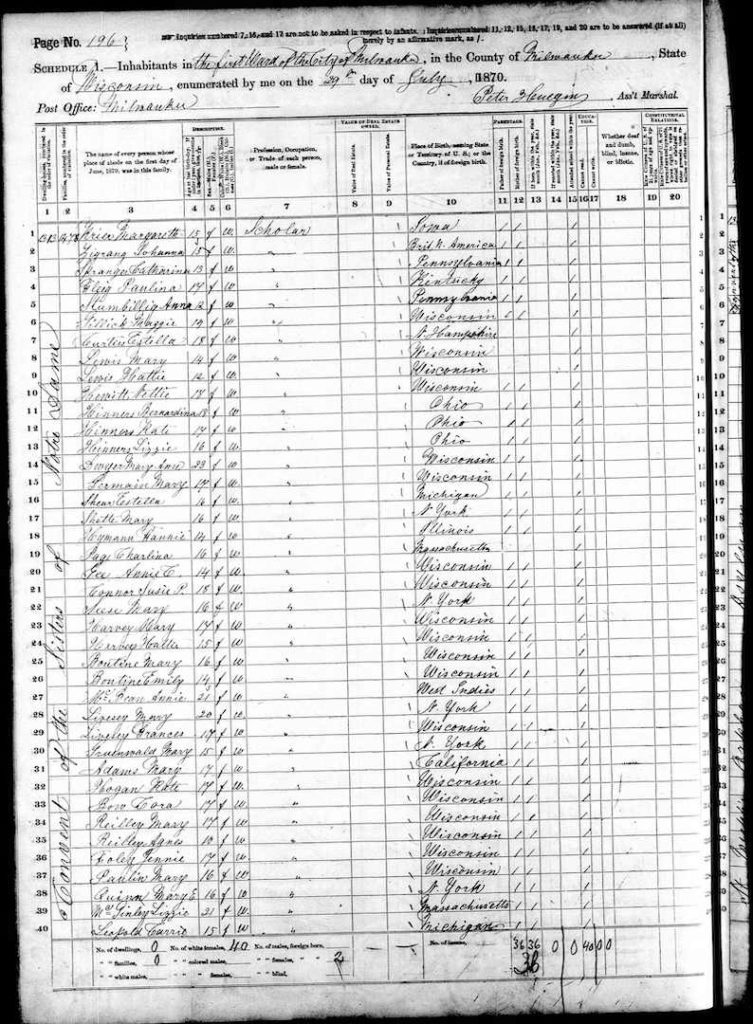
We’ll read about the other Reilly sister, Jennie, below.
In 1872, a “Hugh Reilly” and “Hugh Riley” of Wisconsin are both listed on a declaration for naturalization:
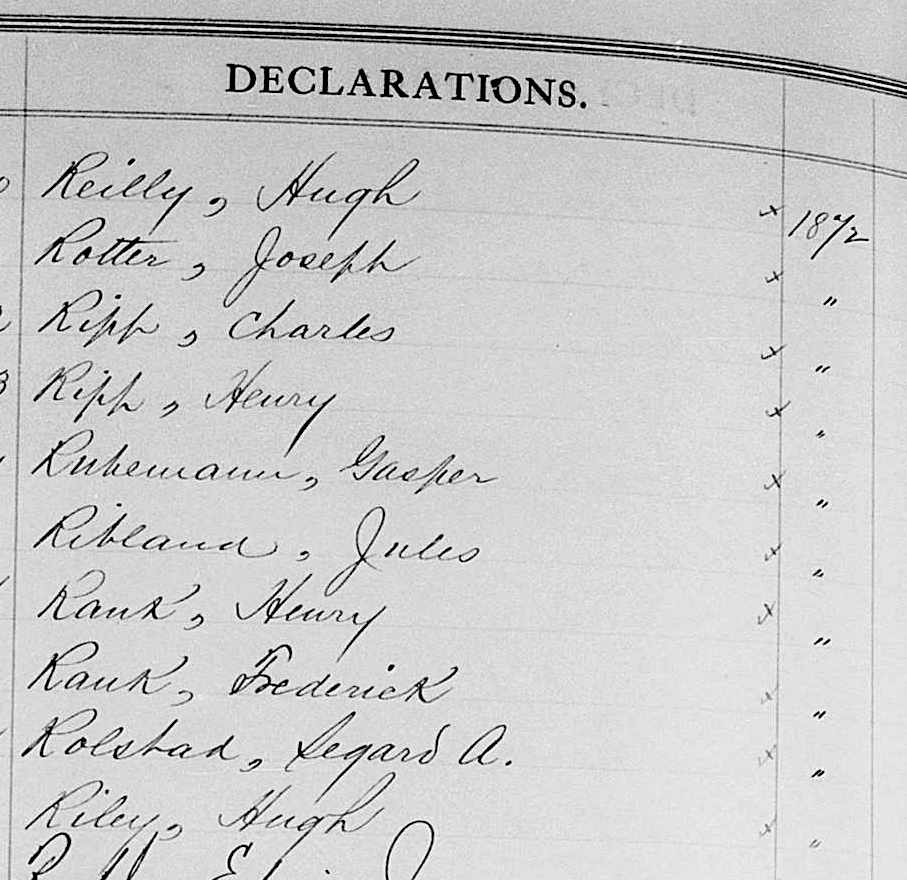
That same year, (our ancestor) son Daniel Reilly moved to Jersey City, NJ (seemingly with younger sister Agnes who would be listed with him on the 1880 census. He remained there for the rest of his life and raised his own family with local girl Mary Murphy (whom he married in 1876). It appears Daniel started out in 1872 as some sort of clerk before later becoming a bookkeeper (1876) and eventually a corner store proprietor/stationer/varieties/printer and, in the 1890s, a carpenter:

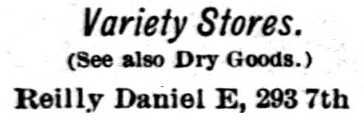

We’ll discuss Daniel’s life and family in Jersey City in a later blog post.
In October 1873 both a “Thomas Rilly” and “Hugh Riley” are naturalized in WI:
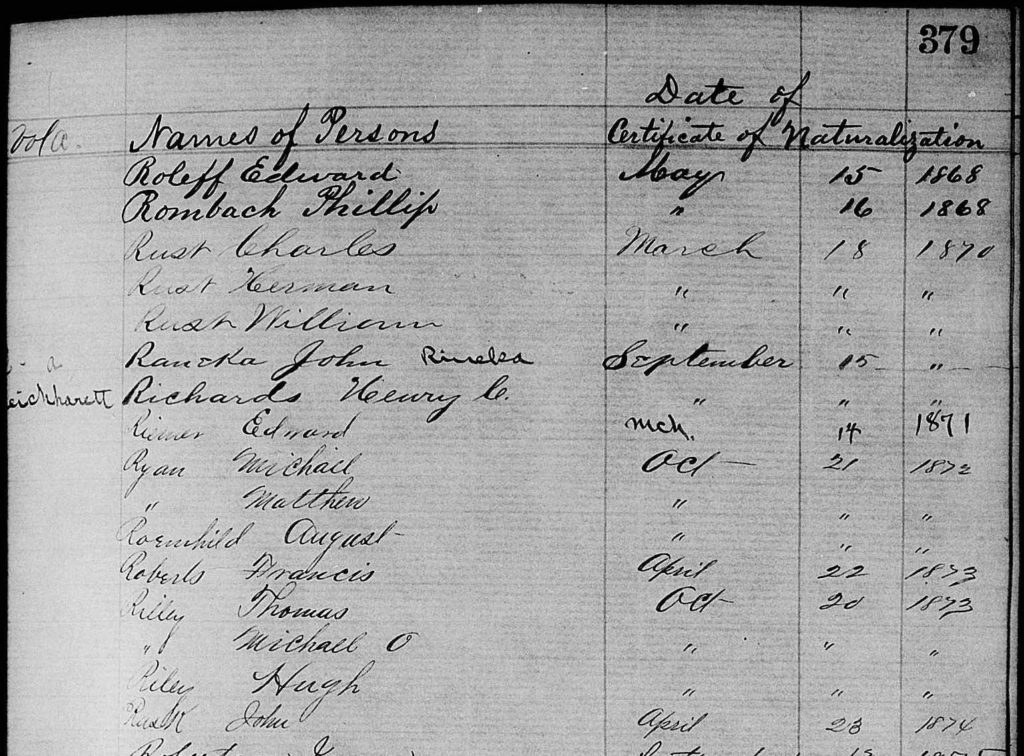
In Wauwatosa, diagonally down and to the right across the Plank Road from the Reilly farm, the city had built a hospital during Hugh’s lifetime. In November 1874, one of its patients came to visit Hugh and immediately died upon arrival:
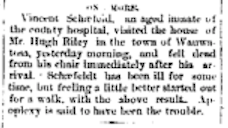
By the time of this 1876 map, the Reilly farm had been further reduced to 90 acres, with Daniel Wells Jr. now possessing Hugh’s former property in the SW corner of Section 20 but with Hugh retaining the site of the house. You can see the location of the hospital on the map in relation to the Reilly farm (section 28, “County Farm”):
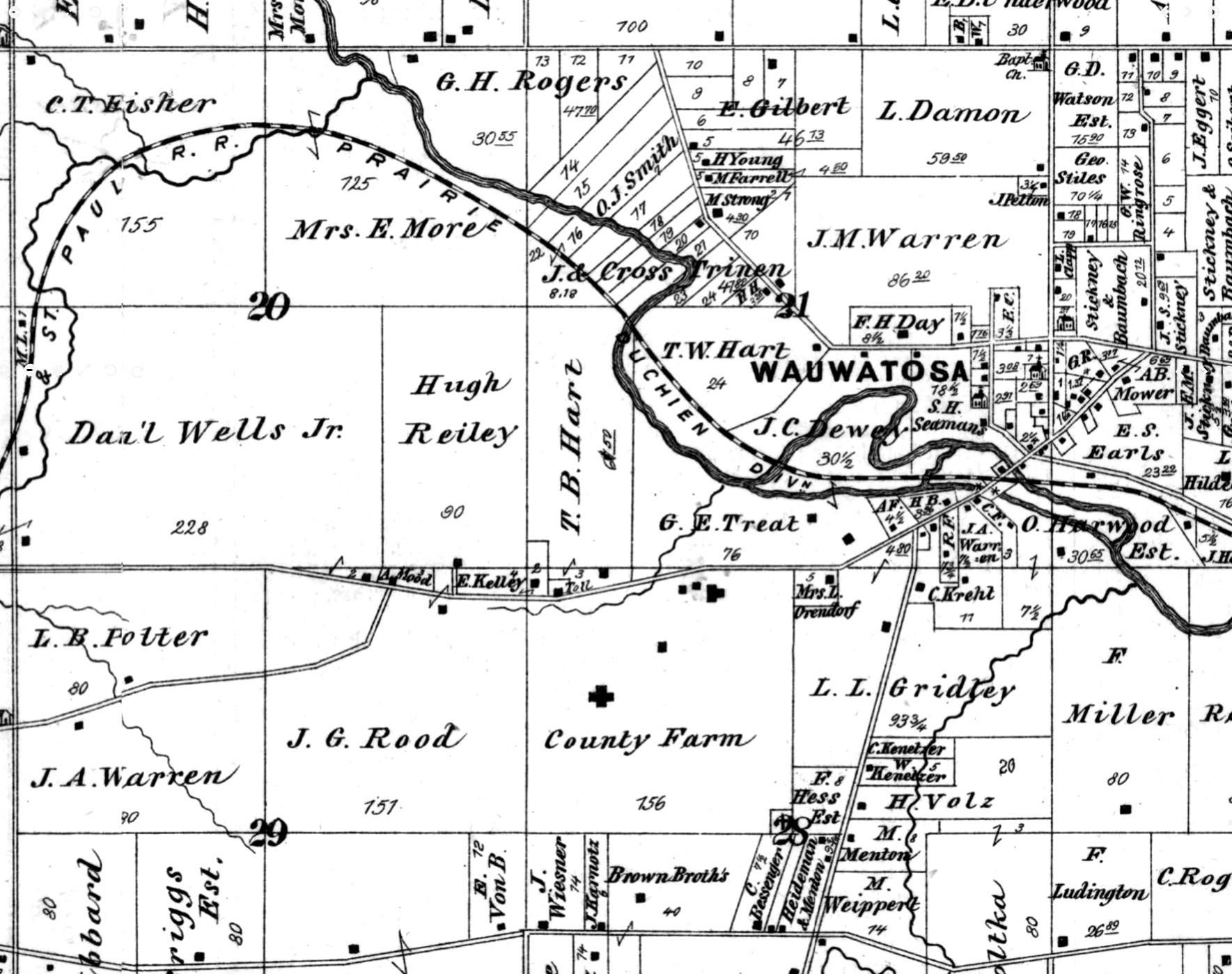
That same year, the Milwaukee County Atlas featured illustrations of various Wawautosa farms, including Hugh’s “backyard neighbors” Charles T. Fisher and Mrs. E.A. More (whose names and houses you can see marked along the road on the upper left/top of the map above):
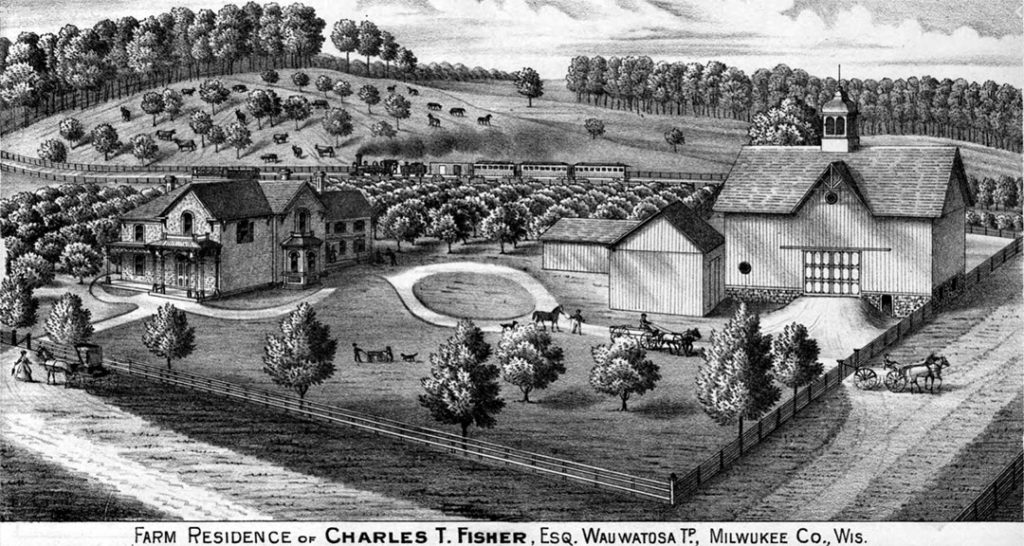
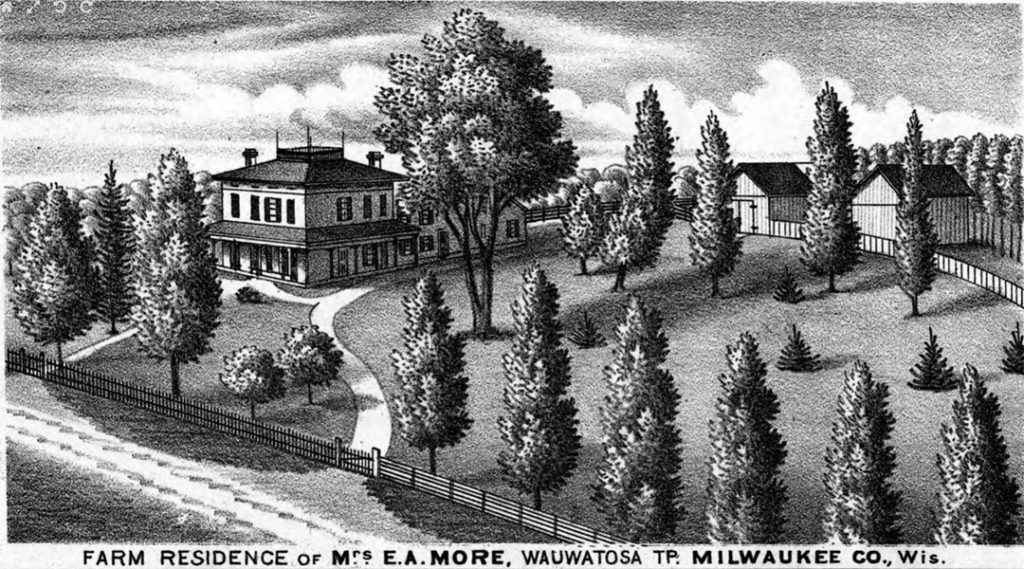
Daniel Wells Jr. was Hugh’s neighbor at this time as seen on the map just above. This 1931 article described Wells’ old farmhouse being razed and also mentions the Mason family, who can be found at the same location on an even older map above. Hugh’s landlord/nemesis William Underwood seems to have moved to the farmhouse in 1849, which was shortly after the Reilly’s arrived in the area:

On August 16, 1877, it seems Hugh remarried to a Clara Briggs in Milwaukee. On the maps above we see a Briggs farm diagonally to the lower left across the Plank Road from the Reilly farm. Below is the marriage record where we find our Hugh’s parents’ names and place of birth:
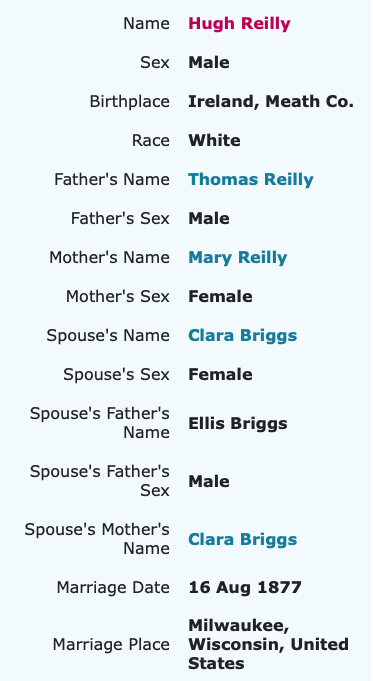
By 1879 (over 35 years since arriving to farm in Wauwatosa), Hugh is no longer listed on the map, with L. Falbe now residing there in the old house:
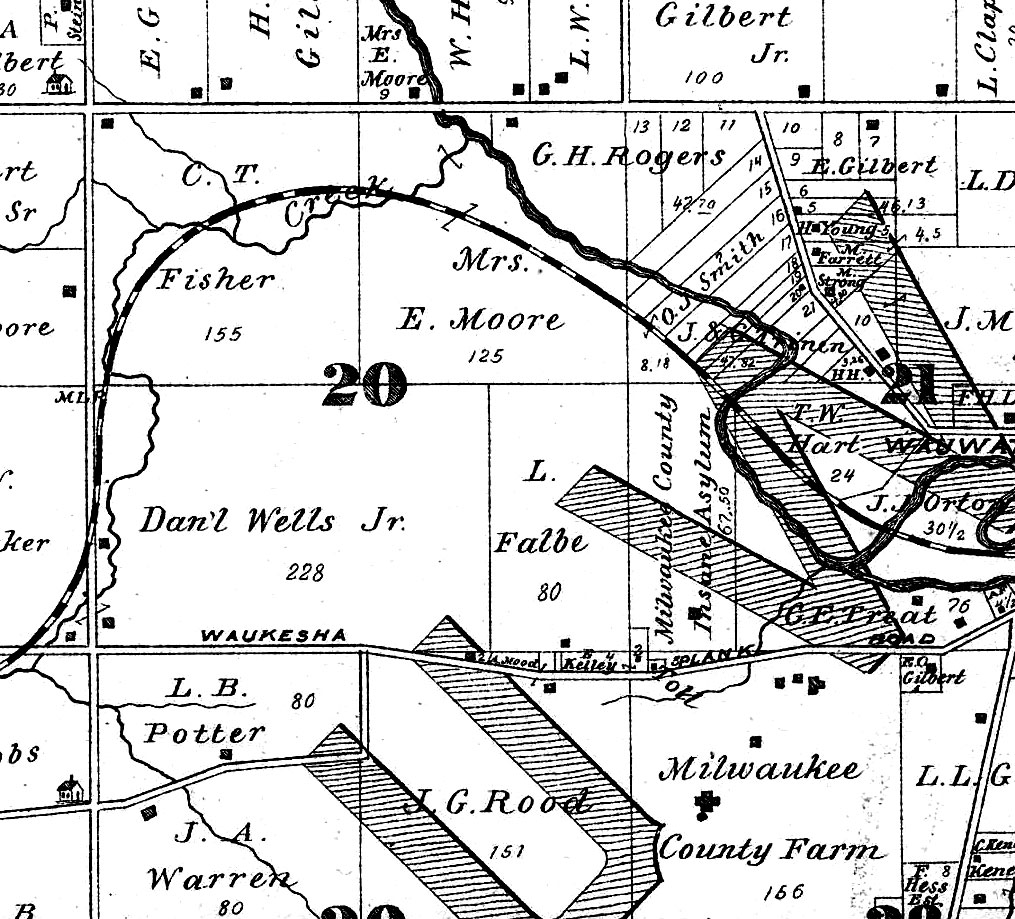
Assuming the 1877 marriage record above is indeed our Hugh and the “Hugh Rielly” on line 29 of the 1880 Milwaukee census below is also him living “at leisure”, his second marriage did not last long (“Divorced”). Hugh was living in the same dwelling as the Isaac Franck/Frank family at 545 12th St., less than 5 miles from the old farm (on a street within what is now a college campus). Hugh was a lone Irishman in a German neighborhood:
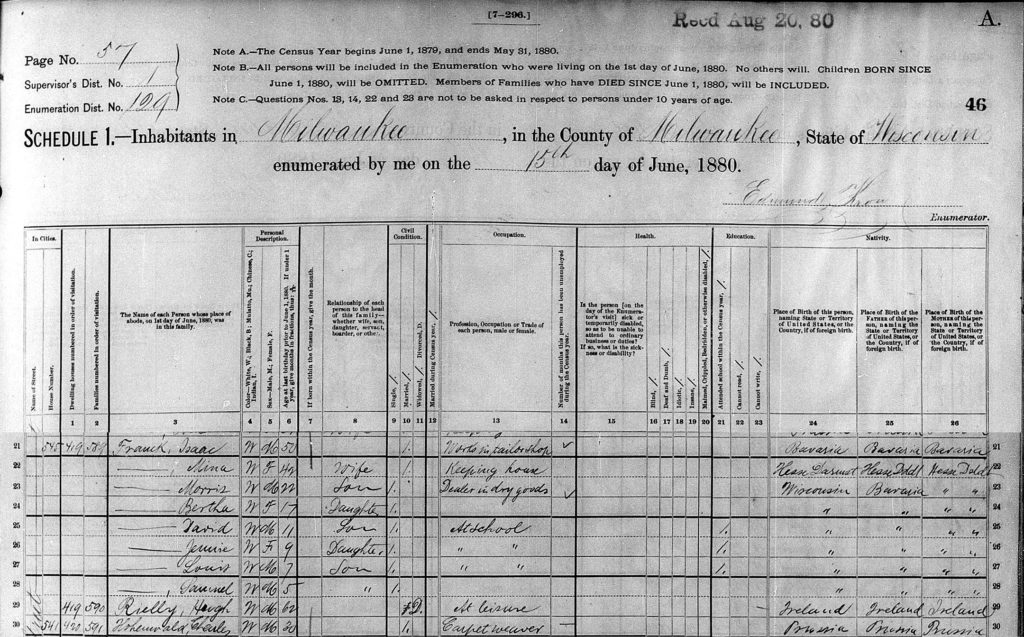
Several years later, on the night of Saturday, January 5, 1884, a massive fire broke out at the Belleville Academy of Immaculate Conception in Belleville, IL and took the lives of 26 people (21 of them students), with one of the deceased teachers being Hugh’s daughter Jennie Riley. These poor victims were either trapped in the building or had jumped out of windows to try to escape the flames.
The event was covered in newspapers around the country. Here is one example:

Jennie Riley (known at the convent as Sister Moderata as highlighted above) was the younger sister of Daniel Reilly and was seemingly listed as “Jane” on the censuses shown above. Here is what is believed to be a tintype photo of her from our family collection:
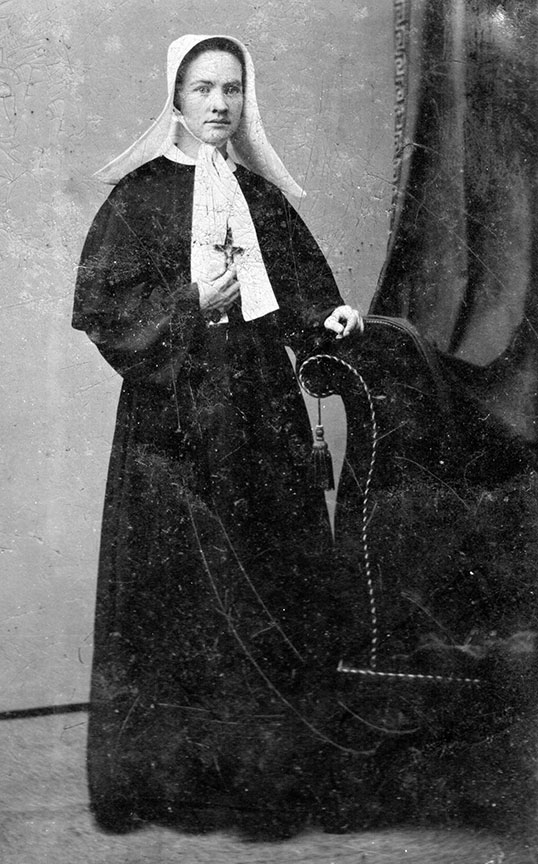
Further details about her death were offered in this article from the Mt. Morris (NY) Enterprise:
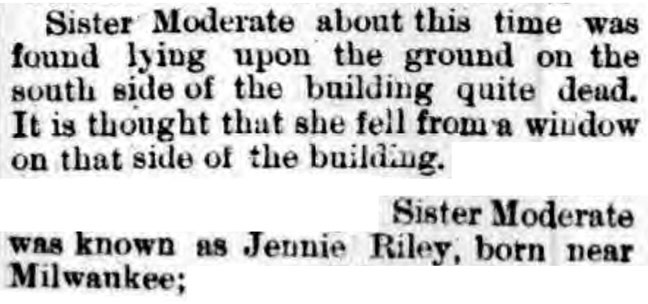
Additional details found at Find A Grave (see link to the cemetery listing below) state:
“Sister Moderata, the Prefect of Studies, had actually escaped when she re-entered the burning building to rescue the sacred vessels for the chapel. Having accomplished this, she had to jump to safety. By this time, the ground around the structure was muddy and slippery from the water being used to douse the fire. When Sister Moderata jumped, she slipped in the mud on landing and fractured her skull on a rock.”
As horrible as this tragedy was, the newspaper coverage of Jennie’s death published on January 10, 1884 (in The Saturday Evening [Menasha, WI] Press) gave some very detailed and unique insight into Jennie and our Reilly family, including what became of Hugh after he left his farm. There is also a reference to Jennie’s brother in Louisiana (Thomas, who lived in Pass Christian), and Daniel in NJ, who (as described earlier) moved to Jersey City in 1872. We even get a quote from the next youngest son William!
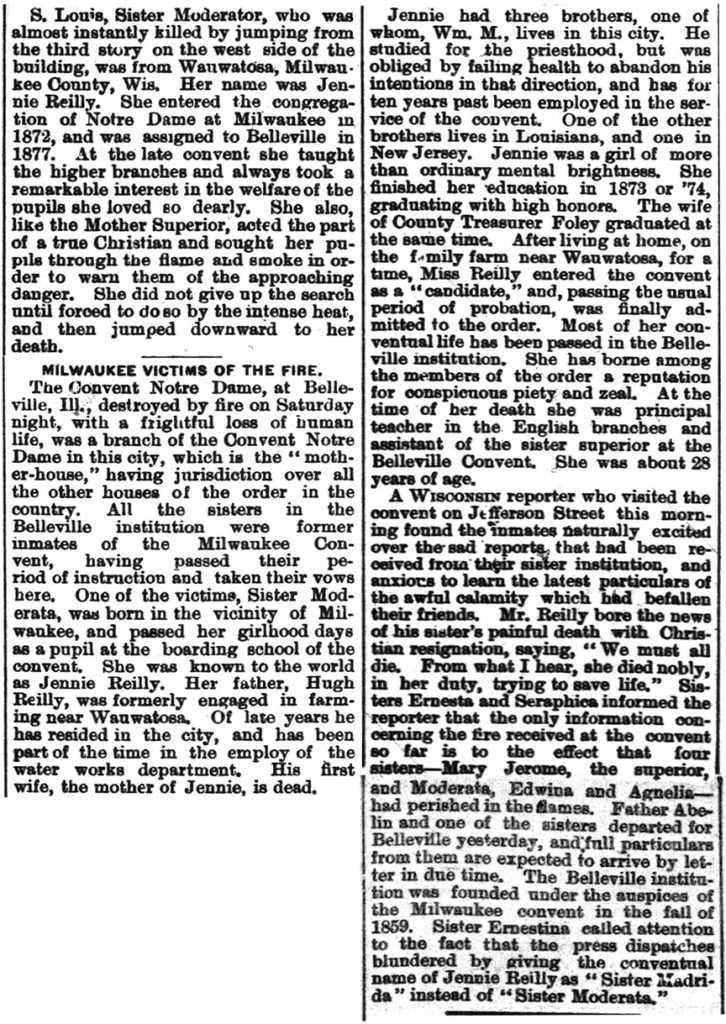
(Notice that Jennie’s mother was referred to as Hugh’s “first wife”, which implies the remarriage we saw above.)
Here are a few visuals of Jennie’s school, before and after the fire:
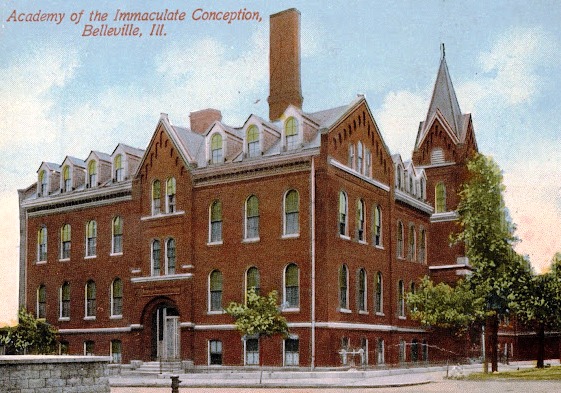
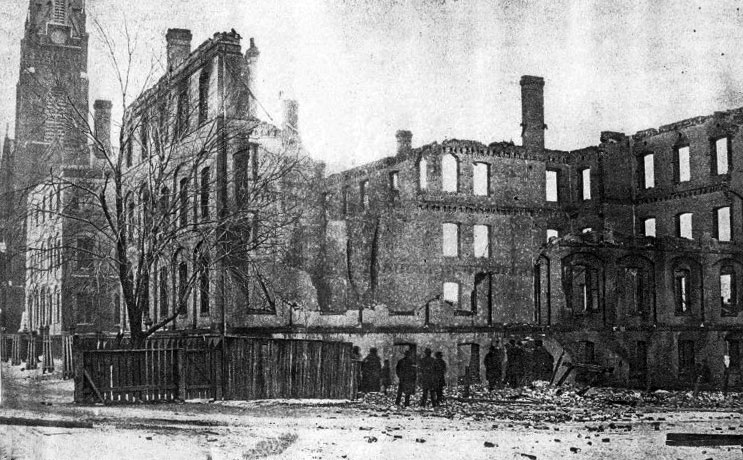

Sr. Moderata, Jennie Riley, is remembered with this marker at the Green Mount Catholic Cemetery:

This online memorial also mentions Jennie’s older sister Mary Florentine (you can see a Mary on the 1860 census above, though (as mentioned earlier) the facts differ between this Mary who died in 1919 and a Mary Reilly that died in 1929 who was a daughter of Hugh).
It appears Hugh died almost three years after this incident, in December 1886, in Milwaukee where he had moved after leaving the farm in Wauwatosa several years earlier:

He was buried in the “County Farm Cemetery”, which seems to be located diagonally SE from his former farm, as seen in the map above:
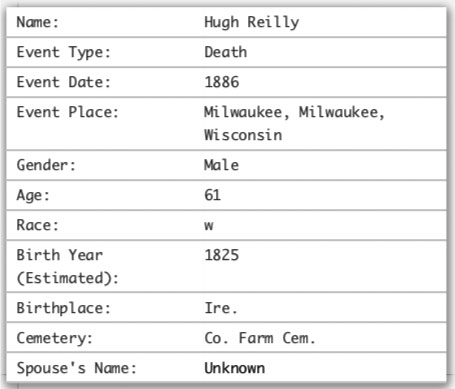
This raises some disturbing possibilities. If you visit “The Milwaukee County Poor Farm Cemetery Project” you can read about cemetery excavations that were performed when renovations and new constructions occurred at the current hospital site. Many graves were discovered and removed, both on that site and also closer to Hugh’s farm. Cemeteries 4 and 3 are on or near the former Reilly farm (notice the Plank Road in red crossing the center of the map below); Cemetery 2 is on the hospital grounds and its use covers the time period of Hugh’s 1886 death (1882-1925):
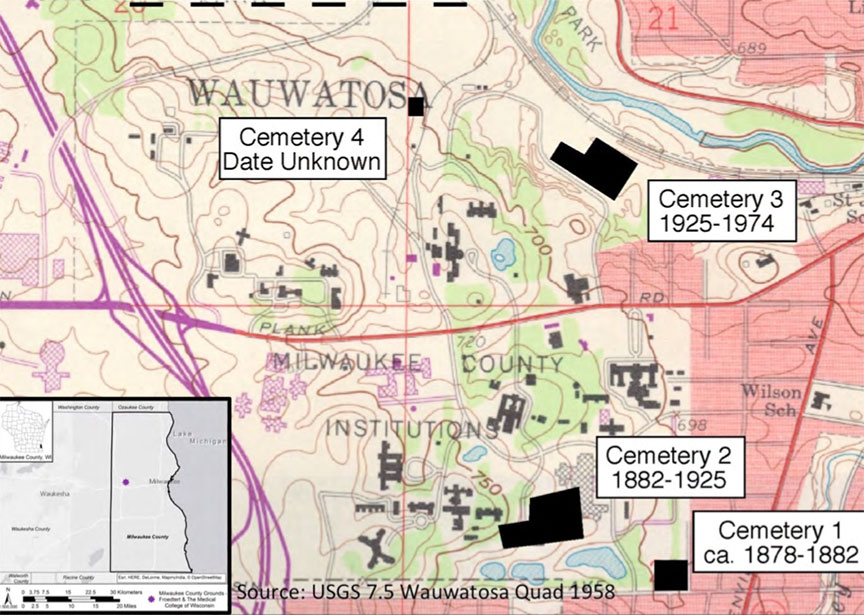
Follow-up on Hugh’s ex-wife Clara Briggs: It seems that several months after Hugh’s death and exactly 10 years (+2 days) from the date she married Hugh in 1877, Clara remarried to Daniel Sullivan in Milwaukee on August 18, 1887:
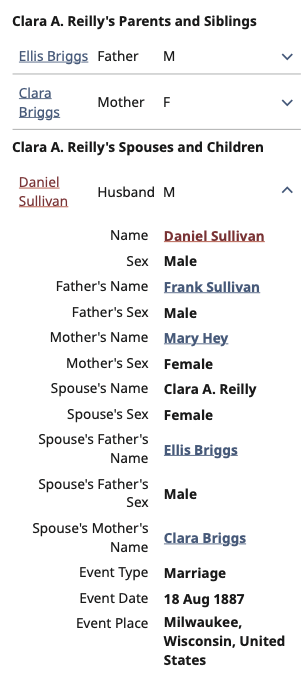
At this point it’s been a long time since Hugh Reilly left his farm along the Watertown Plank Road in the late 1870s. As you can imagine, the former farms of Wauwatosa have been developed and changed in appearance quite a bit over the years since.
It turns out that the exact location of Hugh’s former farmland is quite an interesting and controversial site in Wauwatosa, up through the present time. And surprisingly enough, some of Hugh’s open farmland still exists there!
Let’s take a look at the use and development of the land since Hugh’s death before we follow the Reilly children to their new homes around the country in the next blog post.
The best way to get up to speed on the former Reilly farm is to Google “Milwaukee Country Grounds“. Among the results you will get is information about Wauwatosa’s Sanctuary Woods which describes the land immediately to the east of the farm. The Insane Asylum shared a border with Hugh’s farm, being built not far from his farmhouse shortly after Hugh left.
As a quick overview of the history of the Grounds, I’ll offer some aerial photos to give you a better idea of the evolution of the area over the decades. The first image gives a list of buildings built literally on the same hill where the Reilly house once stood:
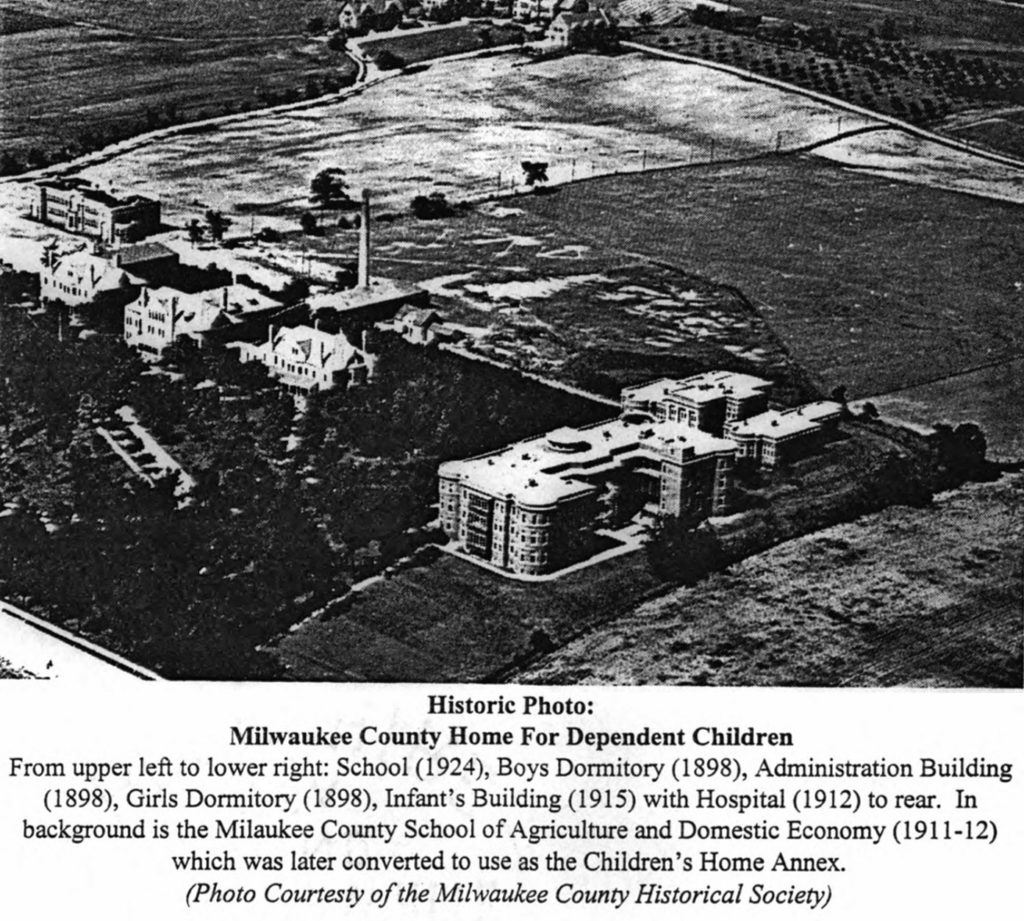
A 1937 aerial shows the same hills in the lower center of the image. Compare the distinctive loop of the railroad with the older maps above:
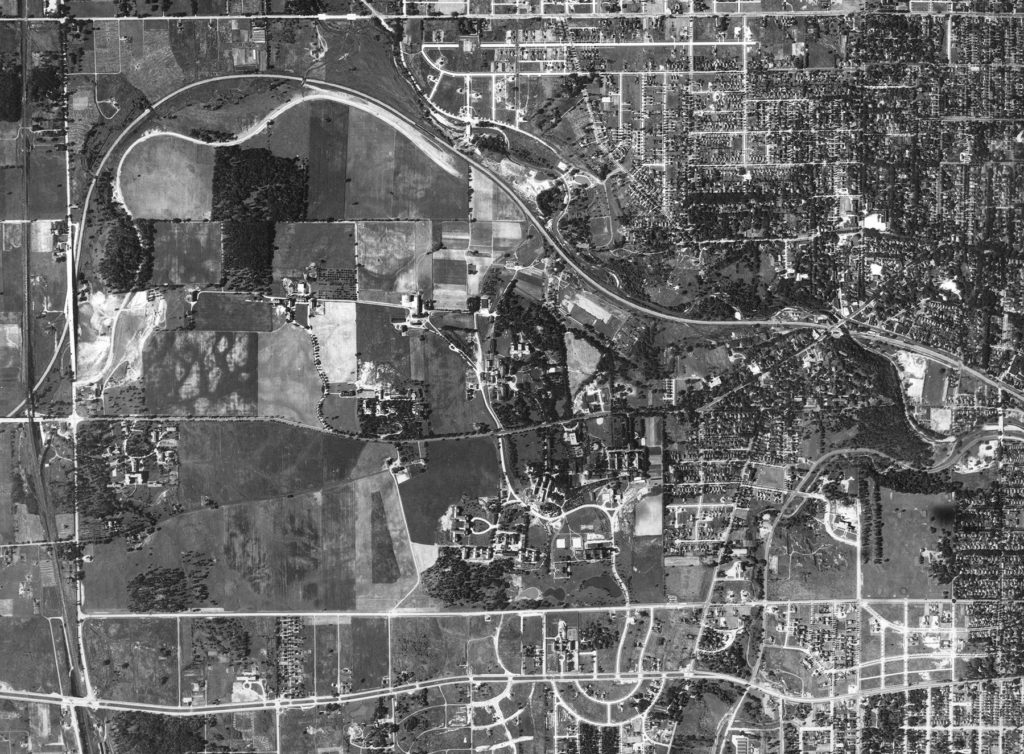
Another 1937 view shows the institutions on the same hill, looking NW:
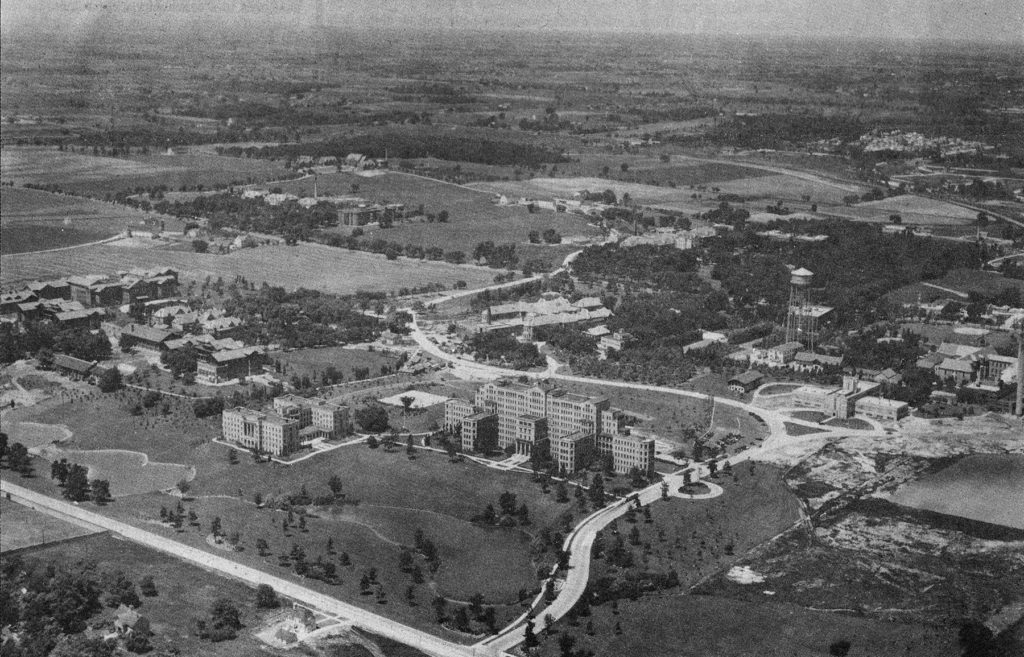
A 1963 aerial shows a new highway and other roads now running through Hugh’s old property:

A modern day aerial view showing even more development:
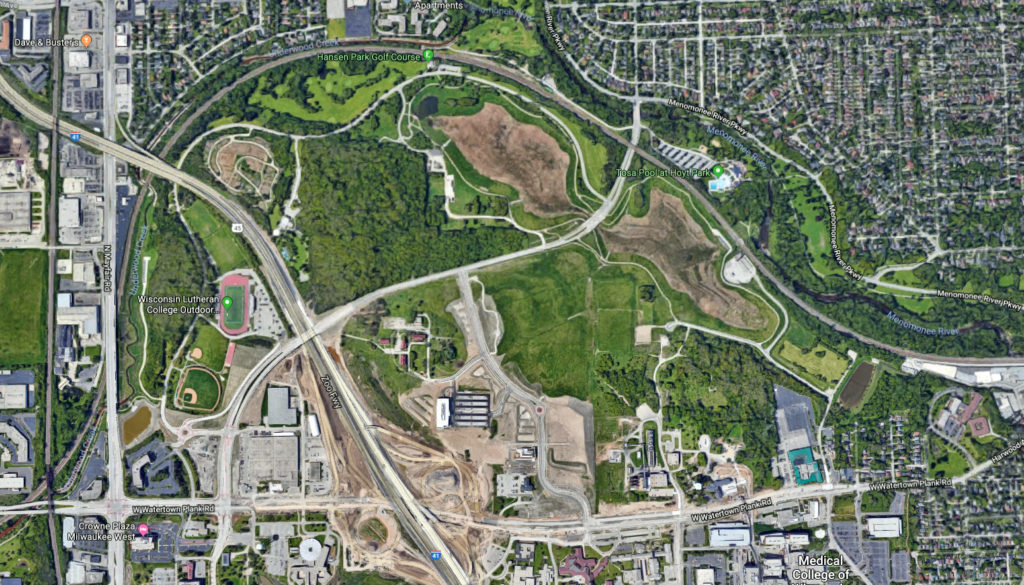
Now let’s overlay the old 1800s farm maps with the old and new aerial photos to see exactly where the Reilly property relates to the ground features, then and now:
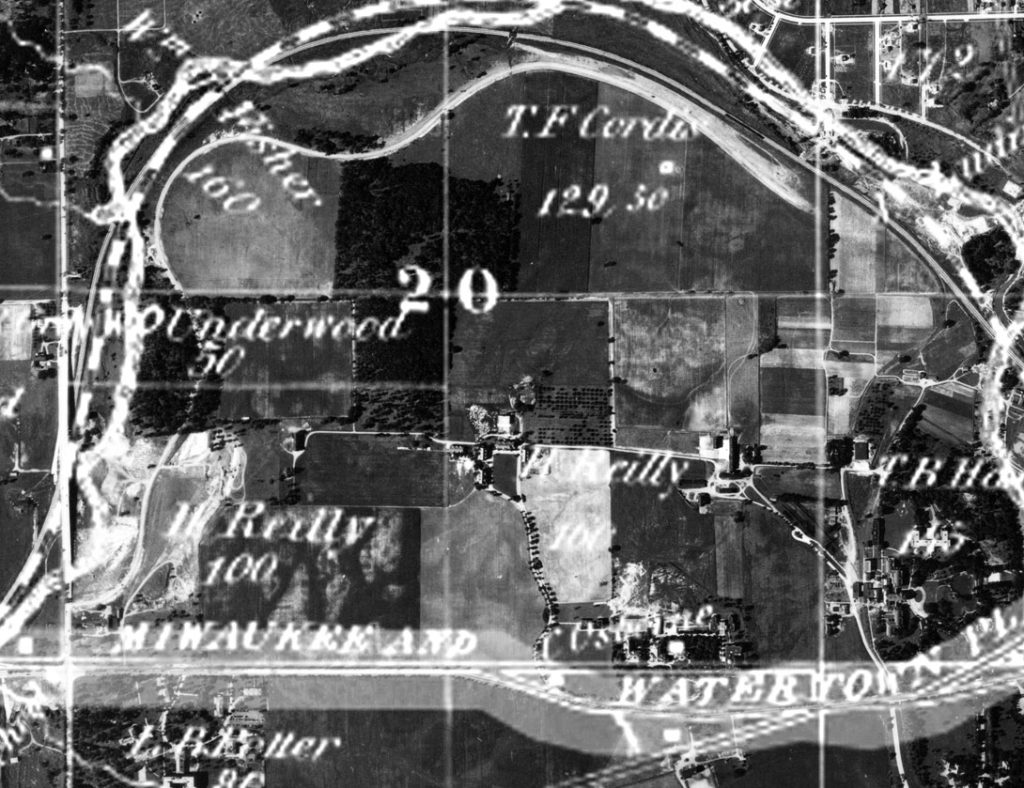
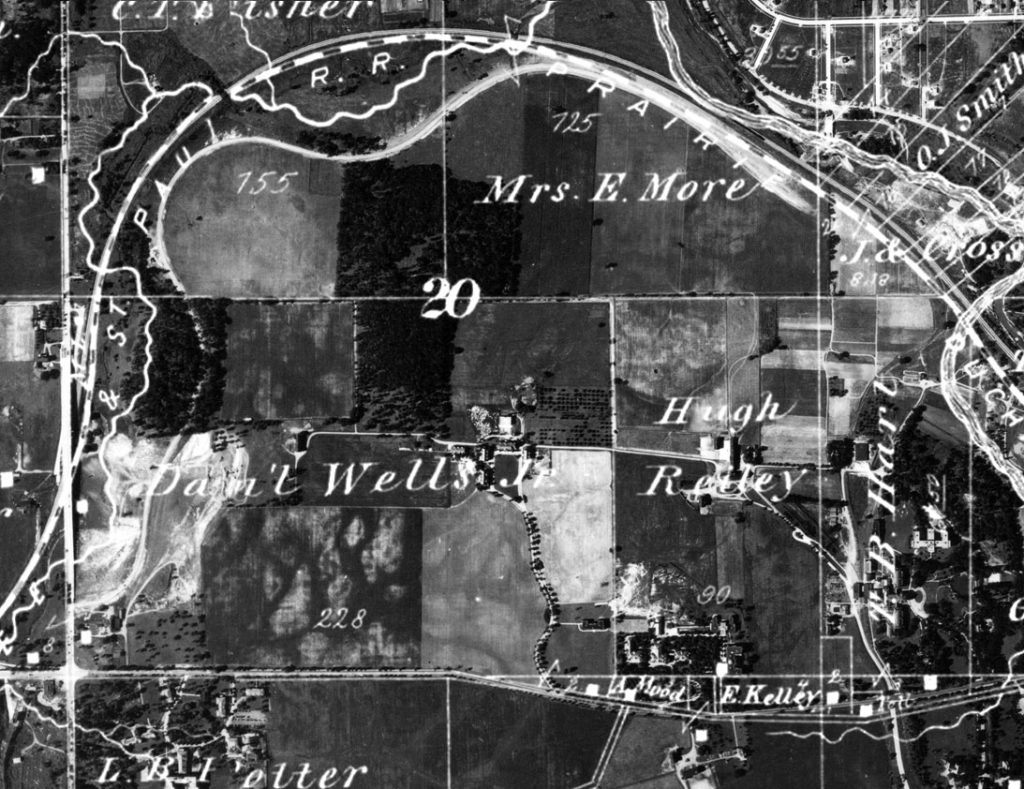
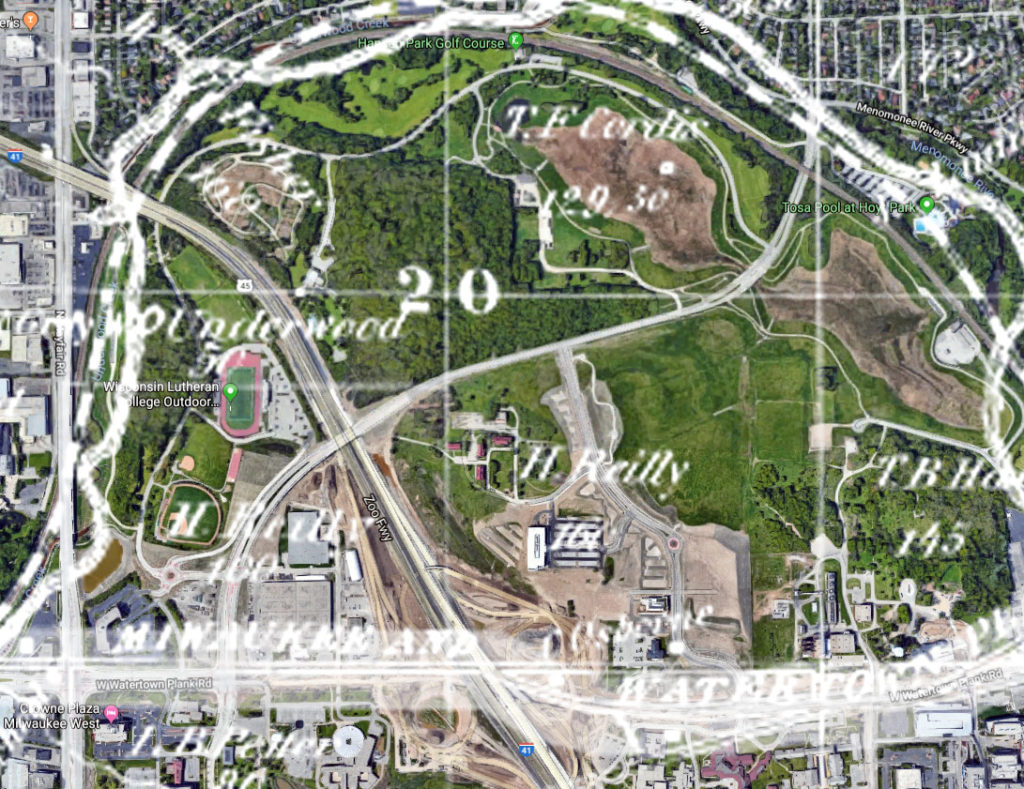
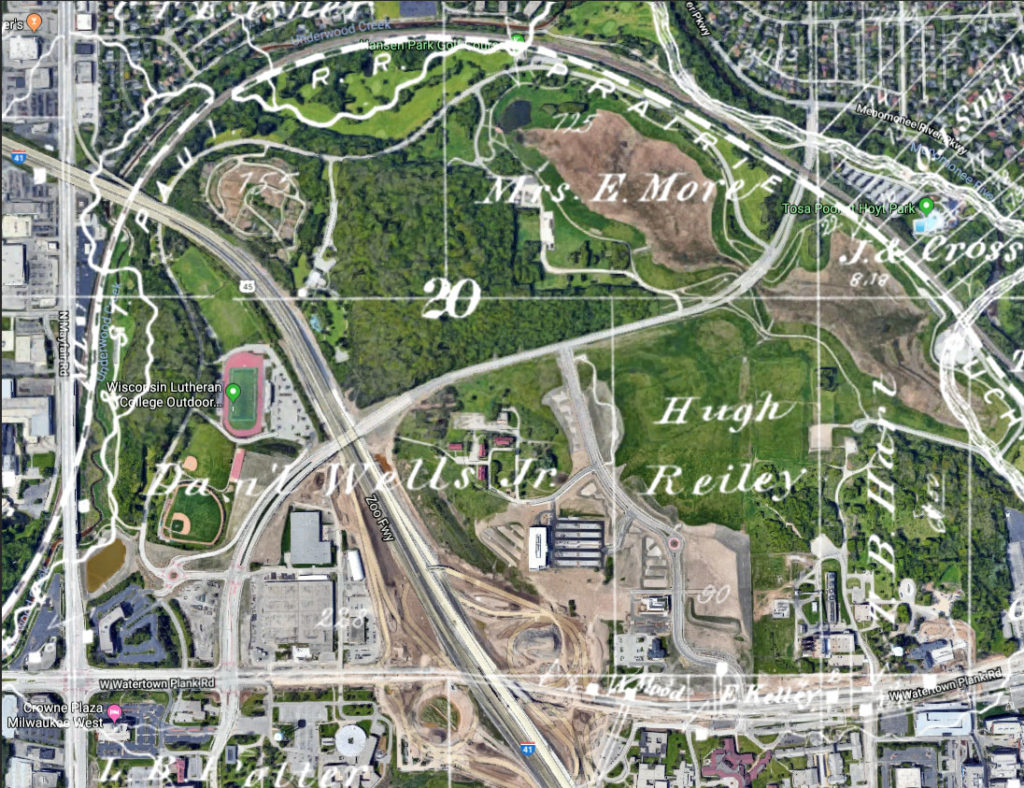
Based on the old maps and satellite views, I’ve determined the Reilly house stood on the hill exactly where the current Discovery Parkway entrance road cuts through the hillside (approximate area shown below in 2011 before construction and present day, from different aerial angles):
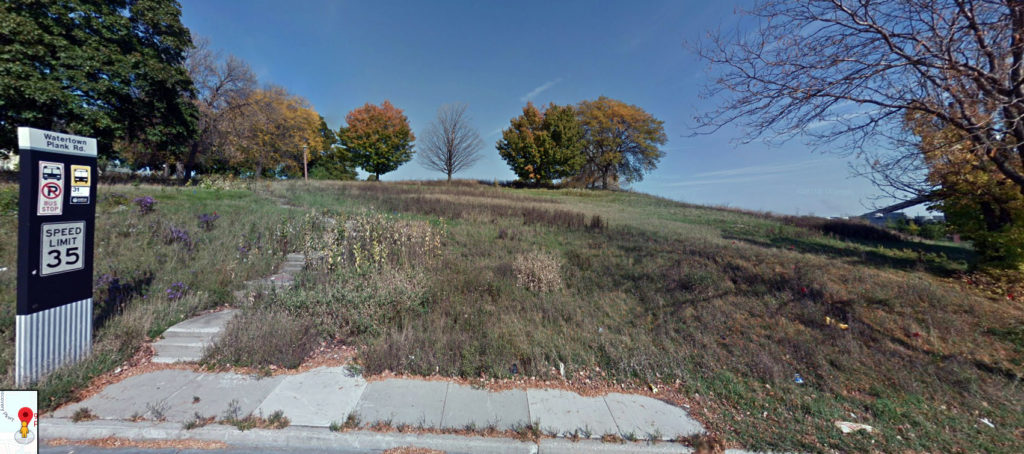
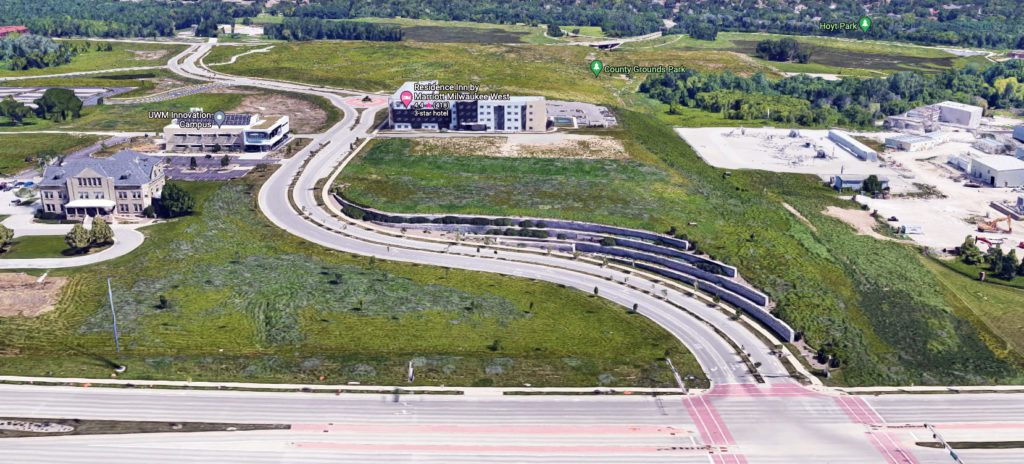
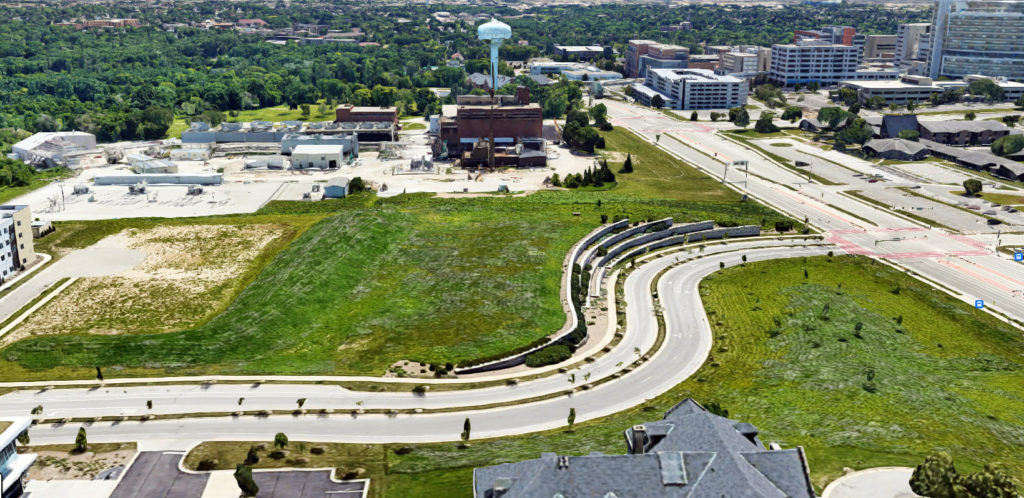
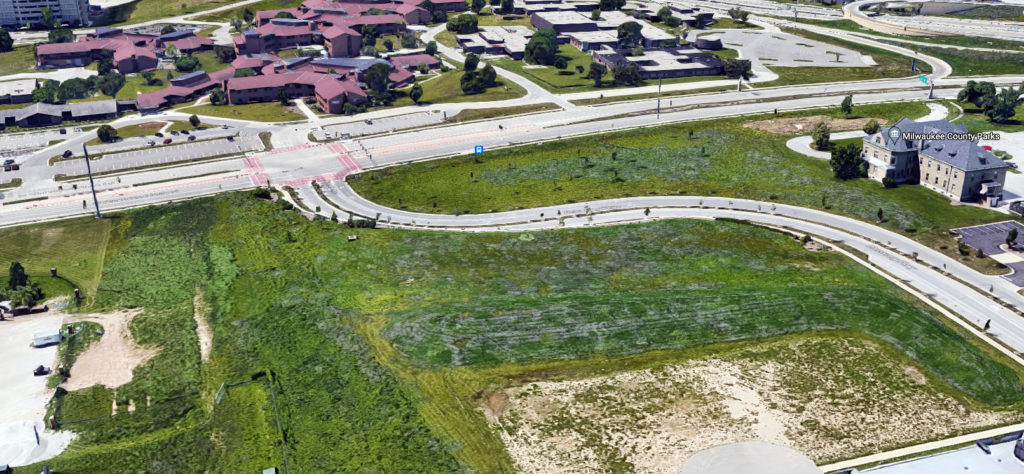
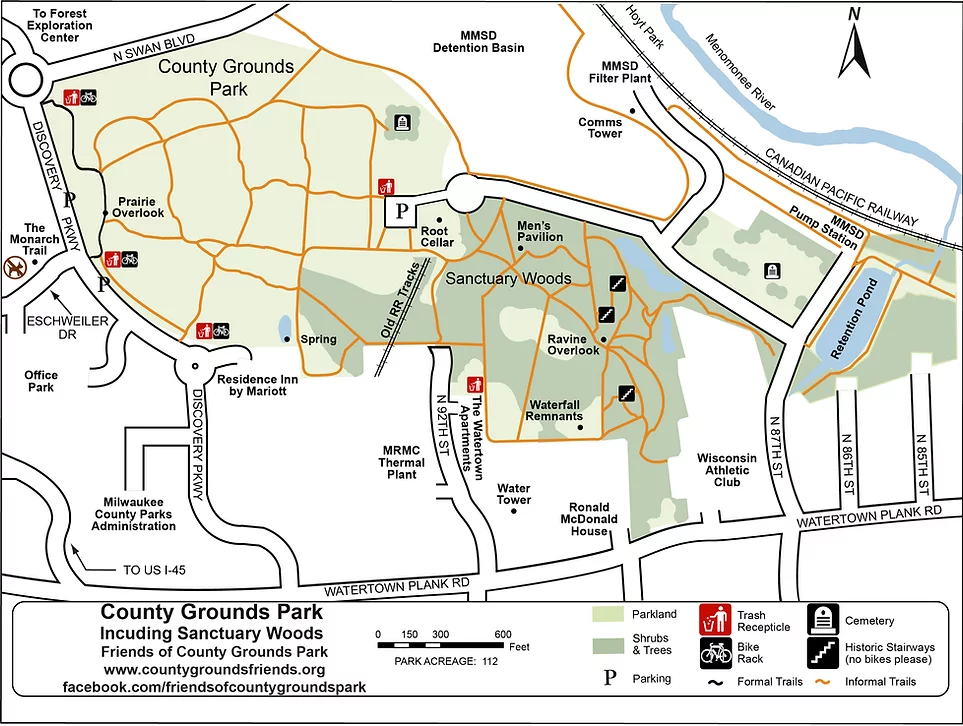
Looking down at the old Milwaukee County Hospital across the road from the Reilly hilltop, in an older photo:
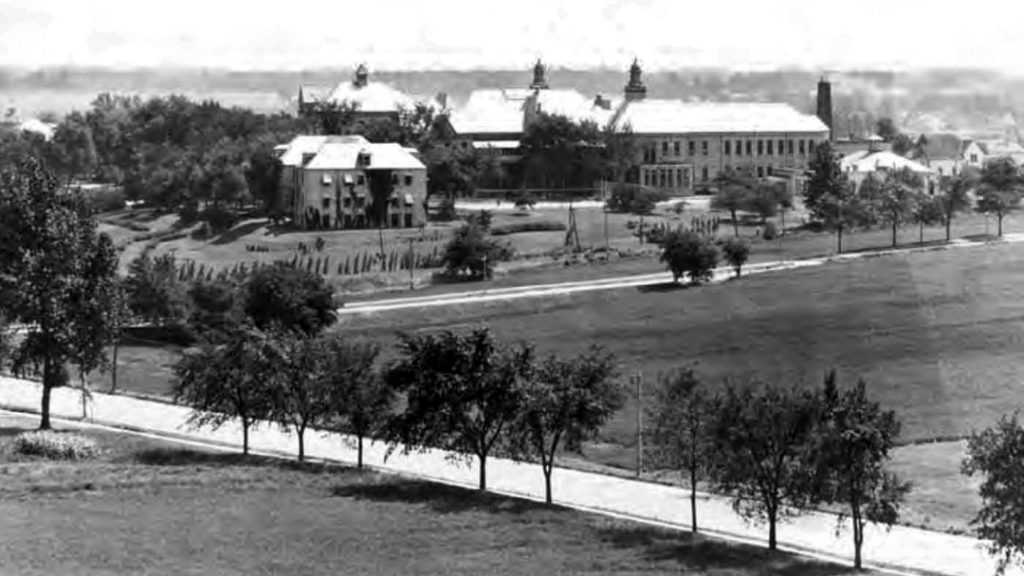
That pretty much sums up the story of the Hugh Reilly family in Wauwatosa WI! As we end I’ll leave you with some modern photos of the remaining bits of Hugh’s farm that you can visit today:
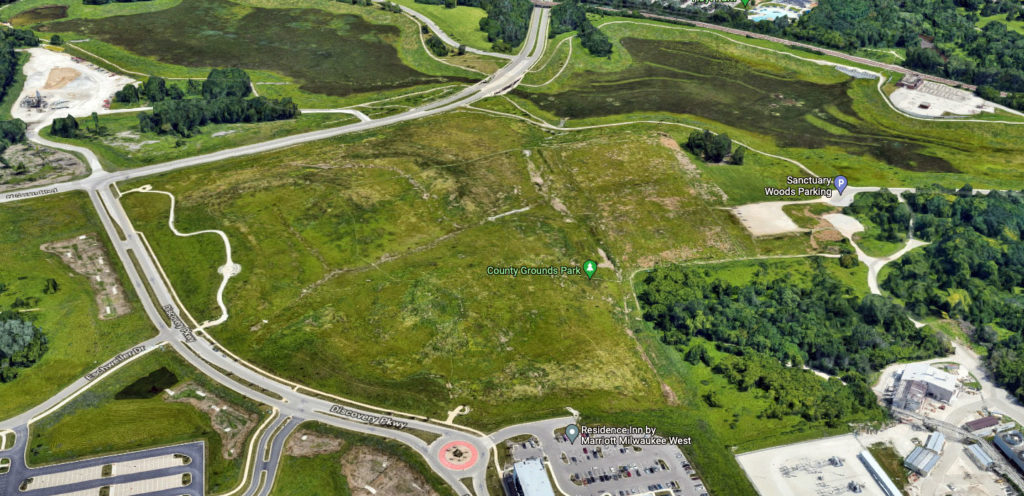
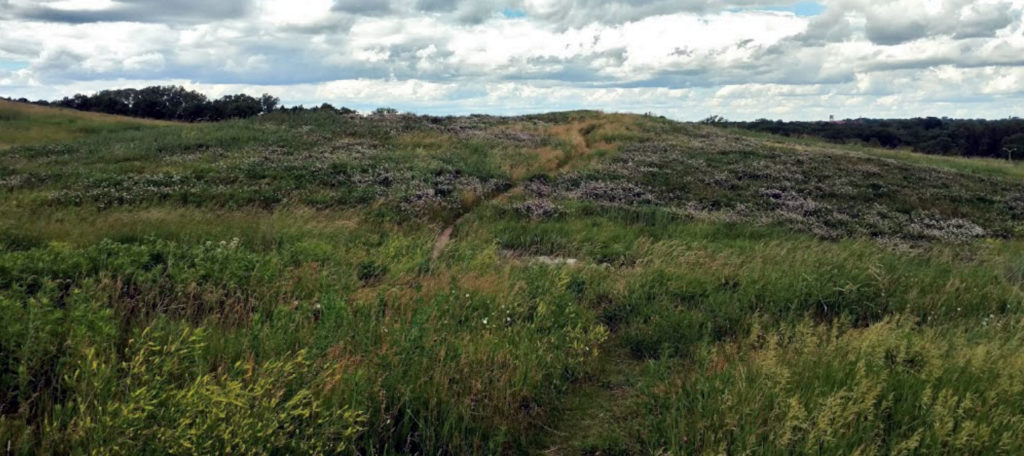
NEXT: The Reilly children make their way off the farm and around the country.